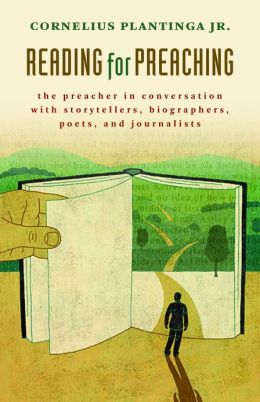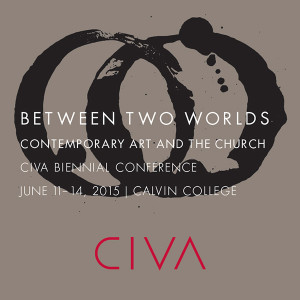 A few weeks ago we had a schedule conflict and couldn’t make a trek to Grand Rapids, Michigan to the bi-annual CIVA (Christians in the Visual Arts) conference. Although we truly enjoyed being with local friends, pastors and lay delegates of a Central PA denominational gathering, we missed being at the remarkable national meeting of CIVA. We need to publicly thank the leadership of CIVA and our stalwart supporter from Lancaster, PA, Ned Bustard, for helping us get a display of books there, sans Beth & Byron, and for Mr. Bustard for representing us at the event.
A few weeks ago we had a schedule conflict and couldn’t make a trek to Grand Rapids, Michigan to the bi-annual CIVA (Christians in the Visual Arts) conference. Although we truly enjoyed being with local friends, pastors and lay delegates of a Central PA denominational gathering, we missed being at the remarkable national meeting of CIVA. We need to publicly thank the leadership of CIVA and our stalwart supporter from Lancaster, PA, Ned Bustard, for helping us get a display of books there, sans Beth & Byron, and for Mr. Bustard for representing us at the event.
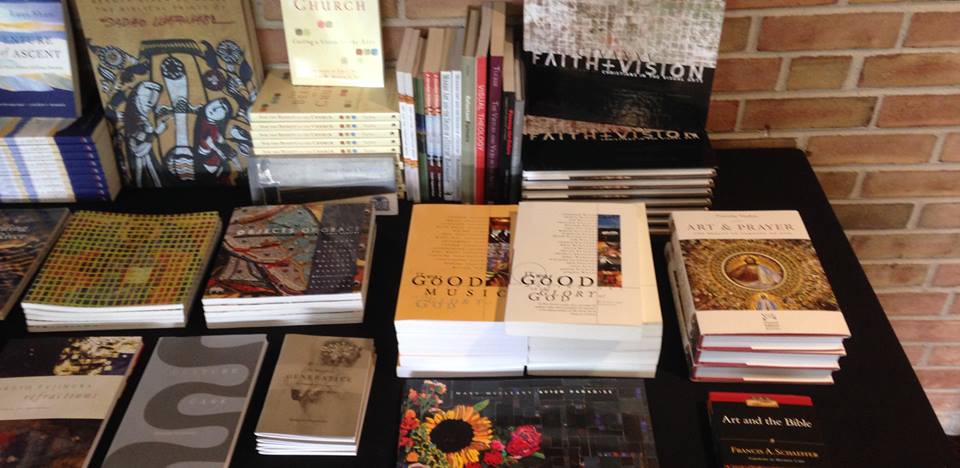 Since we couldn’t have dozens of tables, display racks, or take our boards and shelves to make a pop- up bookstore the way we do at some large events, we only sent a handful of titles and, still, the artists, art teachers, art historians, patrons, museum curators, critics and those who do ministry among and for artists all seemed glad to see our titles. We thank those who browsed and bought books from us — it means a lot. It reminds us of how important cultural creatives and those thinking about aesthetics have been to us in our work. We are grateful.
Since we couldn’t have dozens of tables, display racks, or take our boards and shelves to make a pop- up bookstore the way we do at some large events, we only sent a handful of titles and, still, the artists, art teachers, art historians, patrons, museum curators, critics and those who do ministry among and for artists all seemed glad to see our titles. We thank those who browsed and bought books from us — it means a lot. It reminds us of how important cultural creatives and those thinking about aesthetics have been to us in our work. We are grateful.
LISTS LISTED
Over the years we have developed numerous lists of books or columns about our book-selling at IAM or CIVA or other gatherings where we’ve served serious artists and those interested in culture-making. Please see (and send to others, if you know anyone who’d appreciate it) lists of books about the interface of faith and thea arts here, here or here, or, just for instance, see my review of Beauty Given by Grace: The Bible Prints of Sadao Watanabe, here. Or our review of Art That Tells the Story edited and compiled by Chris Brewer, here.
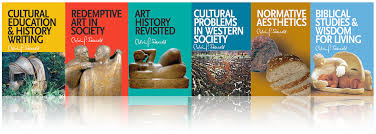 Not long ago I insisted in a Hearts & Minds BookNotes column that last year’s release of a multi-volume set by Calvin Seerveld was “the publishing event of the year.” His stunning and influential classic,
Not long ago I insisted in a Hearts & Minds BookNotes column that last year’s release of a multi-volume set by Calvin Seerveld was “the publishing event of the year.” His stunning and influential classic,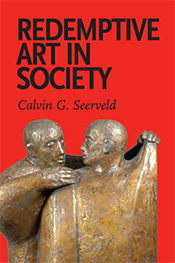
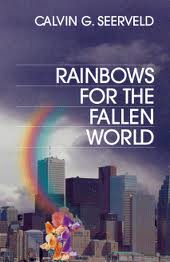 Rainbows for the Fallen World (Toronto Tuppence Press; $30.00), appears on nearly every list on the arts I do, so these newly compiled anthologies of essays, articles, scholarly pieces, sermons and sundry projects — like Normative Aesthetics or Redemptive Art in Society — are important. For what it’s worth, I had the great privilege of being asked to pre-read and then write a blurb for Redemptive Art. More important and knowledgeable critics have offered better endorsements, but since you are a Hearts & Minds fan, figure you might like to see part of this quote of mine, from the back of the book:
Rainbows for the Fallen World (Toronto Tuppence Press; $30.00), appears on nearly every list on the arts I do, so these newly compiled anthologies of essays, articles, scholarly pieces, sermons and sundry projects — like Normative Aesthetics or Redemptive Art in Society — are important. For what it’s worth, I had the great privilege of being asked to pre-read and then write a blurb for Redemptive Art. More important and knowledgeable critics have offered better endorsements, but since you are a Hearts & Minds fan, figure you might like to see part of this quote of mine, from the back of the book:
Can high quality, properly nuanceful, allusive theatre, sculpture, painting or song help heal the world? Can art expose injustices, bring comfort to the hurting, shake the idols of our age? These chapters are amazing pieces, a true gift for those wanting to go further along the journey towards “seeking the peace of the city.” Wise leaders and faithful artists simply must read them.
![Art in Action_thumb[2].jpg](https://www.heartsandmindsbooks.com/images/old/Art%20in%20Action_thumb%5B2%5D.jpg) Dr. Seerveld was at the CIVA conference this year, as were a fine array of other very important writers and supporters of artists. Nicholas Wolterstorff (who – I might shamelessly note – has a chapter in the book I edited called Serious Dreams: Bold Ideas for the Rest of Your Life) was there. His book Art in Action: Toward a Christian Aesthetic (Eerdmans; $26.00) is a classic in this field, published by Eerdmans in 1980, the same year as Rainbows for the Fallen World. I like to tell the story that I learned of both in a splendidly stimulating pair of reviews in Vanguard magazine that year, called “Cal on Nick, Nick on Cal.” It was important for me to learn of these two Christian philosophers, understanding from their excellent academic work what people meant by the “integration of faith and scholarship” as well as the realization that even those within the same worldview community could disagree about how to go about doing “uniquely Christian scholarship” in a particular field of the Lord. Perhaps I took it a bit too much to heart, since are bookstore is very diverse, with “left right and center” viewpoints on offer, enhancing, we hope, principled discussions within each area of life, and each academic or vocation arena, as we ponder and discern what it truly looks like to “think Christianly” and live faithfully, in but not of the world. I thank God for Cal and for Nick, and to realize they were both at this historic CIVA conference and that we would not, was nearly painful. If you don’t have Art in Action, you really should.
Dr. Seerveld was at the CIVA conference this year, as were a fine array of other very important writers and supporters of artists. Nicholas Wolterstorff (who – I might shamelessly note – has a chapter in the book I edited called Serious Dreams: Bold Ideas for the Rest of Your Life) was there. His book Art in Action: Toward a Christian Aesthetic (Eerdmans; $26.00) is a classic in this field, published by Eerdmans in 1980, the same year as Rainbows for the Fallen World. I like to tell the story that I learned of both in a splendidly stimulating pair of reviews in Vanguard magazine that year, called “Cal on Nick, Nick on Cal.” It was important for me to learn of these two Christian philosophers, understanding from their excellent academic work what people meant by the “integration of faith and scholarship” as well as the realization that even those within the same worldview community could disagree about how to go about doing “uniquely Christian scholarship” in a particular field of the Lord. Perhaps I took it a bit too much to heart, since are bookstore is very diverse, with “left right and center” viewpoints on offer, enhancing, we hope, principled discussions within each area of life, and each academic or vocation arena, as we ponder and discern what it truly looks like to “think Christianly” and live faithfully, in but not of the world. I thank God for Cal and for Nick, and to realize they were both at this historic CIVA conference and that we would not, was nearly painful. If you don’t have Art in Action, you really should.
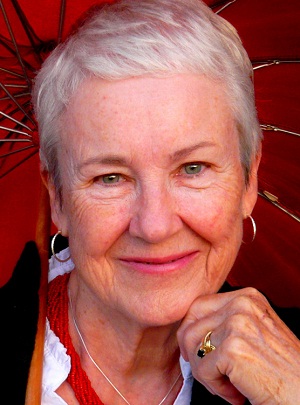 Another person we admire from a far was there, poet and author (and publishing hero) Luci Shaw. We stock her several volumes of lovely, thoughtful poetry, and her wonderful book about being a
Another person we admire from a far was there, poet and author (and publishing hero) Luci Shaw. We stock her several volumes of lovely, thoughtful poetry, and her wonderful book about being a 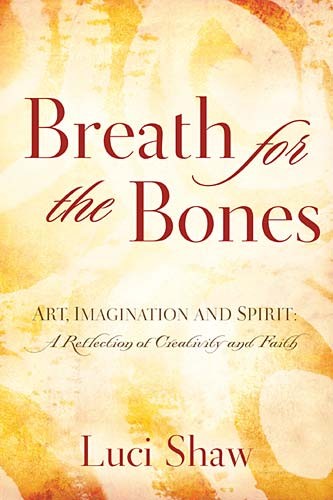 Christian in the arts, Breath for the Bones: Art, Imagination and Spirit: Reflections on Creativity and Faith (Nelson; $13.99.) I recently skimmed it again, for the umpteenth time, alongside an old favorite, a classic by her best friend, the last Madeline L’Engle, Walking on Water: Reflections on Faith and Art (Waterbrook; $18.99.) I would tell those uninitiated to this genre – books about faith and the arts – to read Shaw before L’Engle, but anyone who keeps a library of a few books across the broad school curriculum — campus ministers, say, or “faith in the work-world” geeks or just those who like to read very widely — should have them both.
Christian in the arts, Breath for the Bones: Art, Imagination and Spirit: Reflections on Creativity and Faith (Nelson; $13.99.) I recently skimmed it again, for the umpteenth time, alongside an old favorite, a classic by her best friend, the last Madeline L’Engle, Walking on Water: Reflections on Faith and Art (Waterbrook; $18.99.) I would tell those uninitiated to this genre – books about faith and the arts – to read Shaw before L’Engle, but anyone who keeps a library of a few books across the broad school curriculum — campus ministers, say, or “faith in the work-world” geeks or just those who like to read very widely — should have them both.
Luci’s most recent book of prose is Adventure of Ascent: Field Notes from a Lifelong Journey (IVP; $15.00) which wonderfully surveys the landscape of her experience of aging.
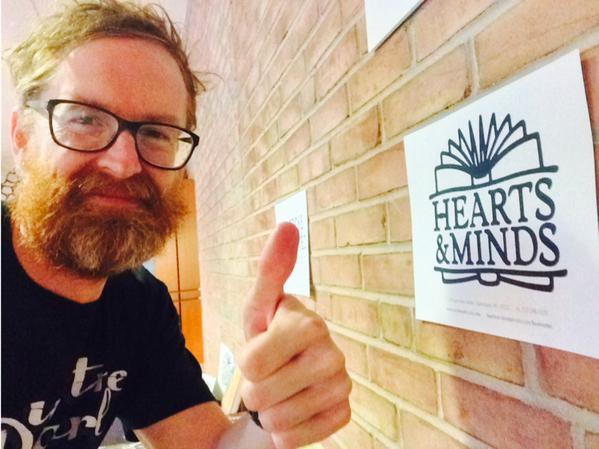
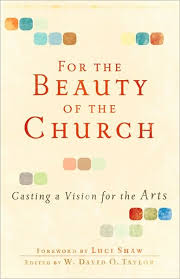 One of the great additions to this field was edited by David O. Taylor, and I really would have liked meeting and hear him at CIVA – Taylor gave the opening address, so, of course, we had a big stack of his edited volume For the Beauty of the Church: Casting a Vision for the Arts (Baker Books; $15.99.) If you are somewhat new to this body of literature, I guarantee you that this will be a great on-ramp, a way into reading about the myriad blessings of beauty, the important issues and concerns, the joys of church-based art ministry. Some of the contributors here are professional artists, a few write about aesthetics and the arts professionally (Jeremy Begbie, John Witvliet, Barbara Nicolosi) and some are just solid church folk interested in the field (Lauren Winner, Eugene Peterson, Andy Crouch.) There is a lovely foreword by Luci Shaw. This is great book, enjoyable and helpful.
One of the great additions to this field was edited by David O. Taylor, and I really would have liked meeting and hear him at CIVA – Taylor gave the opening address, so, of course, we had a big stack of his edited volume For the Beauty of the Church: Casting a Vision for the Arts (Baker Books; $15.99.) If you are somewhat new to this body of literature, I guarantee you that this will be a great on-ramp, a way into reading about the myriad blessings of beauty, the important issues and concerns, the joys of church-based art ministry. Some of the contributors here are professional artists, a few write about aesthetics and the arts professionally (Jeremy Begbie, John Witvliet, Barbara Nicolosi) and some are just solid church folk interested in the field (Lauren Winner, Eugene Peterson, Andy Crouch.) There is a lovely foreword by Luci Shaw. This is great book, enjoyable and helpful.
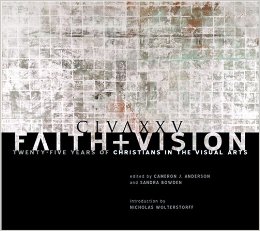
Faith+ Vision: Twenty-Five Years of Christians in the Visual Arts, edited by Cameron J. Anderson and Sandra Bowden with an Introduction by Nicholas Wolterstorff (Square Halo Books) $44.99
It was Square Halo Books, in fact, that partnered a few years ago with CIVA to create and publish a large coffee table book of contemporary Christians in the arts, to honor their 25th anniversary. Modern, postmodern, classic, iconoclastic, heavy, playful, the work represented in Faith+ Vision: Twenty-Five Years of Christians in the Visual Arts, is broad, mature, and evocative. The paintings and other visual art pieces shown are “suggestion-rich” and “allusive” as Seerveld might say, and we are honored to continue to stock it. In fact, I was honored to get to do an endorsement on the back — next to serious scholars in the field such as Ena Heller and Wayne Roosa and William Dyrness. I wrote, very sincerely,
In word and image, the pages of this book record the glorious work of an organization dedicated to support the Christian artist. CIVA is a wonderful association and this book shows off the God-blessed glory of the their members’ work in extraordinary fashion. Thank God for the gentle steadfastness of CIVA,. For those who compiled this excellent books. And for Square Halo who publishes manna like this.
I so wish I knew how to get folks to buy this handsomely designed, inspiring showcase book. The artists deserve to be known, and this organization needs to be supported. It really does make a great gift!
If you want really the “best of the best” standard lists of books, do see the links I offered above. Or write to us, and I can customer make a list, just for you at whatever stage or level you want. The lists are not exhaustive, of course, and we have other titles on the shelves here at the shop, but they will serve as a reliable core curriculum. We have a lot of older “back list” titles at Hearts & Minds, and can get nearly anything in print, so do send us orders if you want.
Now, I’d like to share with you a handful of newer titles, including some of what we showcased at our small showcase in Grand Rapids last month. These are others to celebrate. All are 20% off — do send us an order so we can keep doing this kind of work, promoting Christian scholarship and resources often not found in typical bookstores.
10 RECENT BOOKS ABOUT FAITH AND THE ARTS
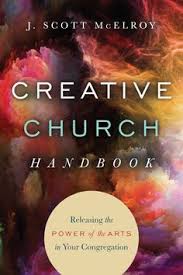 Creative Church Handbook: Releasing the Power of the Arts in Your Congregation J. Scott McElroy (IVP) $20.00 This was one of our biggest sellers at the CIVA Bi-annual, and they honored Scott by arranging a book signing to celebrate it. This book has been years in the making; it includes a report of of various church groups that have robust arts ministries, and offers guidance drawn from them, stuff they’ve learned, insights they’ve gleaned along the way. In this regard, Creative Church Handbook is both interesting/ inspiring – to hear these stories, learn of these ministries and outreaches – and practical/useful — with the “take away” points so clear and actionable. Scott has been involved in conversations about faith and the arts for years, has written an earlier book (Finding Divine Inspiration) and this new, slightly over-sized work illustrates his keen ability to pay attention to what God is doing across the land. It shows how to mobilize and manage artists and other creatives within your congregation and how to establish structures and parameters for arts ministry. It includes good stuff on outreach and engagement with the local arts scene in your own community as well as how to wisely think about utilizing the arts in worship and sermons, even. I’m particularly glad that the arts work of a local church near us here is included; kudos to our neighbor DeAnne Roe for how McElroy described the work over at Living Word Community Church. This book is a must-have resource, highly recommended.
Creative Church Handbook: Releasing the Power of the Arts in Your Congregation J. Scott McElroy (IVP) $20.00 This was one of our biggest sellers at the CIVA Bi-annual, and they honored Scott by arranging a book signing to celebrate it. This book has been years in the making; it includes a report of of various church groups that have robust arts ministries, and offers guidance drawn from them, stuff they’ve learned, insights they’ve gleaned along the way. In this regard, Creative Church Handbook is both interesting/ inspiring – to hear these stories, learn of these ministries and outreaches – and practical/useful — with the “take away” points so clear and actionable. Scott has been involved in conversations about faith and the arts for years, has written an earlier book (Finding Divine Inspiration) and this new, slightly over-sized work illustrates his keen ability to pay attention to what God is doing across the land. It shows how to mobilize and manage artists and other creatives within your congregation and how to establish structures and parameters for arts ministry. It includes good stuff on outreach and engagement with the local arts scene in your own community as well as how to wisely think about utilizing the arts in worship and sermons, even. I’m particularly glad that the arts work of a local church near us here is included; kudos to our neighbor DeAnne Roe for how McElroy described the work over at Living Word Community Church. This book is a must-have resource, highly recommended.
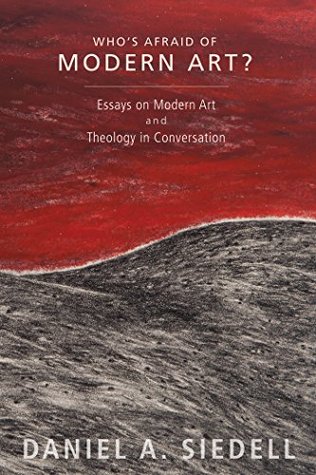 Who’s Afraid of Modern Art? Essays on Modern Art and Theology in Conversation Daniel A. Siedell (Cascade) $21.00 I’m not a fan of the bland cover, but this book is anything but bland, and the always interesting, often passionate Siedell has followed up his seminal God in the Gallery: A Christian Embrace of Modern Art with a great new volume, a must-have for anyone wanting to stay current with the “state of the art” of recent conversations in this field. This fabulous, richly informed new collection of over 30 essays, is grouped into six major themes. Blurbs on the back include one by David Raskin, the influential (atheist) professor of Art History, Theory and Criticism at the Art Institute of Chicago. (“He asks important questions about art and belief, and helps me better understand my own passions.”) and by Gregory Alan Thornbury, President of The King’s College in New York City, who, after avery thoughtful summary, says “This is a landmark work, a signal of achievement in the field.” As it says on the back cover, Who’s Afraid of Modern Art? celebrates the surprising beauty of art that emerges from and embraces pain and suffering, if only we take the time to listen. Indeed, as Siedell reveals, a painting is much more than meets the eye.”
Who’s Afraid of Modern Art? Essays on Modern Art and Theology in Conversation Daniel A. Siedell (Cascade) $21.00 I’m not a fan of the bland cover, but this book is anything but bland, and the always interesting, often passionate Siedell has followed up his seminal God in the Gallery: A Christian Embrace of Modern Art with a great new volume, a must-have for anyone wanting to stay current with the “state of the art” of recent conversations in this field. This fabulous, richly informed new collection of over 30 essays, is grouped into six major themes. Blurbs on the back include one by David Raskin, the influential (atheist) professor of Art History, Theory and Criticism at the Art Institute of Chicago. (“He asks important questions about art and belief, and helps me better understand my own passions.”) and by Gregory Alan Thornbury, President of The King’s College in New York City, who, after avery thoughtful summary, says “This is a landmark work, a signal of achievement in the field.” As it says on the back cover, Who’s Afraid of Modern Art? celebrates the surprising beauty of art that emerges from and embraces pain and suffering, if only we take the time to listen. Indeed, as Siedell reveals, a painting is much more than meets the eye.”
Siedell’s serious essays are arranged in these units: The Ear, The Audience, The Art World, The Artist, The Art, and The Poetics of Modern Art. Fantastic!
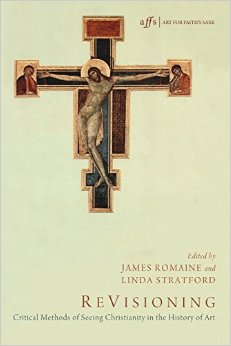 ReVisioning: Critical Methods of Seeing Christianity in the History of Art edited by James Romaine and Linda Stratford (Cascade) $41.00 Mr. Romaine has been known in evangelical art circles for years, in part because of his role in Square Halo Books such as It Was Good: Making Art to the Glory of God, Objects of Grace: Conversations on Creativity and Faith, and The Art of Guy Chase. He is now Associate Professor of Art History and Chair of the Department of Art History at Nyack College. Mr. Romaine is the President of the Association of the Scholars of Christianity in the History of Art (ASCHA – who knew?) He recently helped edit the excellent collection of art history essays done in honor of Dr. John Walford, Art as Spiritual Perception (published by Crossway — I named it as a Best Book of 2012, which you can find in this big list, here.) Linda Stratford is an Associate Professor at Asbury College and a board member of ASCHA as well. I name these important qualifications to assure you that this hefty book is very well done, a collection of exceptional scholars showing forth their work about the methods they use to do faith-informed, coherent art history. To suggest that a book about methodologies within a sub- genre of a certain, technical field — Christianly conceived analysis of art history — is worth reading by non-specialists may sound like a stretch, but I think this stuff is very interesting for any adult learner and think it should be available in church libraries and among those who like to think deeply about these sorts of things. Nearly all of us could benefit from fresh teaching about old stuff, and on one hand we could just consider this a refresher course, a good overview of all kinds of interesting matters. More so, though, we can learn much about our own self-awareness about our methods and tendencies and styles of how we engage culture and scholarship by dipping into these keen approaches to Christian engagement with culture. These grapple with how to think faithfully about how we do just that – how we approach this artifact or that painting or the accepted wisdom about this school of thought or that cultural movement – is very, very helpful.
ReVisioning: Critical Methods of Seeing Christianity in the History of Art edited by James Romaine and Linda Stratford (Cascade) $41.00 Mr. Romaine has been known in evangelical art circles for years, in part because of his role in Square Halo Books such as It Was Good: Making Art to the Glory of God, Objects of Grace: Conversations on Creativity and Faith, and The Art of Guy Chase. He is now Associate Professor of Art History and Chair of the Department of Art History at Nyack College. Mr. Romaine is the President of the Association of the Scholars of Christianity in the History of Art (ASCHA – who knew?) He recently helped edit the excellent collection of art history essays done in honor of Dr. John Walford, Art as Spiritual Perception (published by Crossway — I named it as a Best Book of 2012, which you can find in this big list, here.) Linda Stratford is an Associate Professor at Asbury College and a board member of ASCHA as well. I name these important qualifications to assure you that this hefty book is very well done, a collection of exceptional scholars showing forth their work about the methods they use to do faith-informed, coherent art history. To suggest that a book about methodologies within a sub- genre of a certain, technical field — Christianly conceived analysis of art history — is worth reading by non-specialists may sound like a stretch, but I think this stuff is very interesting for any adult learner and think it should be available in church libraries and among those who like to think deeply about these sorts of things. Nearly all of us could benefit from fresh teaching about old stuff, and on one hand we could just consider this a refresher course, a good overview of all kinds of interesting matters. More so, though, we can learn much about our own self-awareness about our methods and tendencies and styles of how we engage culture and scholarship by dipping into these keen approaches to Christian engagement with culture. These grapple with how to think faithfully about how we do just that – how we approach this artifact or that painting or the accepted wisdom about this school of thought or that cultural movement – is very, very helpful.
The first batch of essays by world class scholars look at icons and iconography. The next handful of pieces look at methodological issues of reading theology in Renaissance and Baroque Art. The third section looks at the historical-religious context of Nineteenth, Twentieth, and even a bit of Twenty-first century art. The authors are from a diverse array of institutions, from The University of Chicago Divinity School to the Pratt Institute , from Duquesne University to several universities throughout the world.
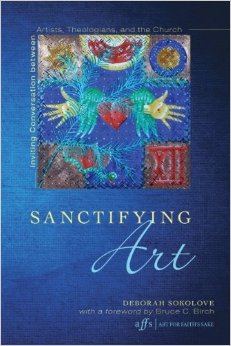 Sanctifying Art: Inviting Conversation Between Artists, Theologians and the Church Deborah Sokolove (Cascade) $22.00 Cascade has an uneven, even peculiar, series, “affs/Art for Faith’s Sake” that is worth knowing about, a series which includes books large and small, including some poetry volumes, a biblical theology of dance, a splendid, mature work by Bill Dyrness (Senses of the Soul: Art and the Visual in Christian Worship), a very nice devotional based on Emily Dickinson, the significant ReVisioning book on art history mentioned above, and, a bit oddly, a teaching preaching book by Will Willimon, among others. This is a solid, foundational one, and should be known widely. As Robin Jenson (herself Professor of the History of Christian Art and Worship at Vanderbilt) says “Deborah Sokolove has given us a rare gift. She has articulated her belief in the value and purpose of art in language that is fresh, convincing, and – perhaps most of all – accessible to and respectful of the lay reader. This is obviously a work of love, and it is a great joy to read.” Many of the reviews and endorsements have been excellent, nearly urgent: Denise Domblkowski Hopkins says that the author “brilliantly accomplished what she set out to do – change the conversation between artists and the church….” and suggests that much is at stake here.
Sanctifying Art: Inviting Conversation Between Artists, Theologians and the Church Deborah Sokolove (Cascade) $22.00 Cascade has an uneven, even peculiar, series, “affs/Art for Faith’s Sake” that is worth knowing about, a series which includes books large and small, including some poetry volumes, a biblical theology of dance, a splendid, mature work by Bill Dyrness (Senses of the Soul: Art and the Visual in Christian Worship), a very nice devotional based on Emily Dickinson, the significant ReVisioning book on art history mentioned above, and, a bit oddly, a teaching preaching book by Will Willimon, among others. This is a solid, foundational one, and should be known widely. As Robin Jenson (herself Professor of the History of Christian Art and Worship at Vanderbilt) says “Deborah Sokolove has given us a rare gift. She has articulated her belief in the value and purpose of art in language that is fresh, convincing, and – perhaps most of all – accessible to and respectful of the lay reader. This is obviously a work of love, and it is a great joy to read.” Many of the reviews and endorsements have been excellent, nearly urgent: Denise Domblkowski Hopkins says that the author “brilliantly accomplished what she set out to do – change the conversation between artists and the church….” and suggests that much is at stake here.
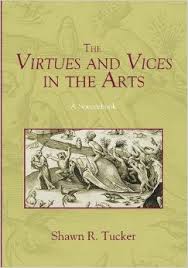 The Virtues and Vices in the Arts: A Sourcebook Shawn R. Tucker (Cascade) $33.00 I have not looked through this much, and wondered if it is mostly about the arts, or mostly about virtue, faith-formation and character. The seven deadly sins are known, perhaps the virtues less so, but this book brings all of them together and “for the first time, lays out their history in a collection of the most important philosophical, religious ,literary and art-historical works.” Is this mostly art history then? Literary criticism? Historical theology? Yes, yes, and yes. It is a massive anthology, putting, in the words of a professor from Bowdoin, “philosophical treatises into conversation with religious and literary compositions. Even more interesting, he draws on key artistic works, paintings, and sculpture, allowing the reader to imagine other ways to think about ethical problems.”
The Virtues and Vices in the Arts: A Sourcebook Shawn R. Tucker (Cascade) $33.00 I have not looked through this much, and wondered if it is mostly about the arts, or mostly about virtue, faith-formation and character. The seven deadly sins are known, perhaps the virtues less so, but this book brings all of them together and “for the first time, lays out their history in a collection of the most important philosophical, religious ,literary and art-historical works.” Is this mostly art history then? Literary criticism? Historical theology? Yes, yes, and yes. It is a massive anthology, putting, in the words of a professor from Bowdoin, “philosophical treatises into conversation with religious and literary compositions. Even more interesting, he draws on key artistic works, paintings, and sculpture, allowing the reader to imagine other ways to think about ethical problems.”
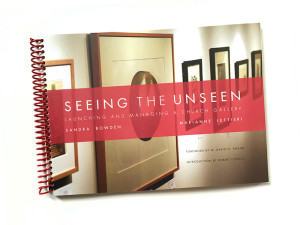 Seeing the Unseen: Launching and Managing a Church Gallery Sandra Bowden & Marianne Lettieri (CIVA) $30.00 This is another splendid, book which was launched at the 2015 CIVA event, and we are thrilled to have a few here at the shop. Sandra Bowden is, we might note, one of the most informed and respected art collectors in North America, herself a devout Christian and driving force within CIVA for decades. (Some of her own splendid collection is shown in a truly exceptional Square Halo Books coffee table art book, The Art of Sandra Bowden, edited by James Romaine; $49.99.) Ms Lettieri is a mixed media artist, art instructor, and is currently in a residency at the Cubberley Artist Studios in Palo Alto, California.
Seeing the Unseen: Launching and Managing a Church Gallery Sandra Bowden & Marianne Lettieri (CIVA) $30.00 This is another splendid, book which was launched at the 2015 CIVA event, and we are thrilled to have a few here at the shop. Sandra Bowden is, we might note, one of the most informed and respected art collectors in North America, herself a devout Christian and driving force within CIVA for decades. (Some of her own splendid collection is shown in a truly exceptional Square Halo Books coffee table art book, The Art of Sandra Bowden, edited by James Romaine; $49.99.) Ms Lettieri is a mixed media artist, art instructor, and is currently in a residency at the Cubberley Artist Studios in Palo Alto, California.
This beautifully crafted new book is 10 x 7, spiral bound, and chock full of insight, vision, and lots of very practical advice. Stepping into this world can be daunting – bad art is an embarrassment and we must resist cheap or unconsidered work, but we must also realize that the power and witness of even the most highly creative, exceptional work can be harmed by shoddy or unprofessional installations. Anyone who is an artist could benefit from this; anyone who is interested in displaying real work by real artists should know this stuff, and anyone who is serious about doing a gallery, especially in a parish setting, simply must have it.
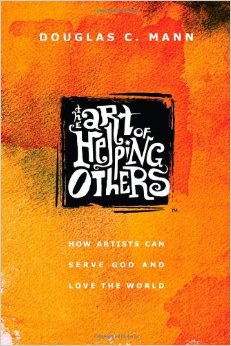 The Art of Helping Others: How Artists Can Serve God and Love the World Douglas C. Mann (IVP) $15.00 Mann is a songwriter and former music and publishing executive (not to mention an accomplished visual artist) and has done extensive mission work. (He currently divides his times between Colorado and the Ukraine.) In this book Mann offers a memoir of his own “joy, pain, sacrifice and hope” which calls artists of all sorts, in fact, all followers of Jesus, actually, to lives of “creative incitement to the glory of God.” Although this will inspire you to invite and network artists for activism and service, it will, more deeply, inspire all of us to live more generously, seeing the world in nuanced, colorful ways, and sharing that passionate vision with others. All of us, artists or not, can be encouraged by this author who, Ben Arment says, “has the hands of an artist and the heart of a pastor.” Maybe we all need a little “creative incitement.”
The Art of Helping Others: How Artists Can Serve God and Love the World Douglas C. Mann (IVP) $15.00 Mann is a songwriter and former music and publishing executive (not to mention an accomplished visual artist) and has done extensive mission work. (He currently divides his times between Colorado and the Ukraine.) In this book Mann offers a memoir of his own “joy, pain, sacrifice and hope” which calls artists of all sorts, in fact, all followers of Jesus, actually, to lives of “creative incitement to the glory of God.” Although this will inspire you to invite and network artists for activism and service, it will, more deeply, inspire all of us to live more generously, seeing the world in nuanced, colorful ways, and sharing that passionate vision with others. All of us, artists or not, can be encouraged by this author who, Ben Arment says, “has the hands of an artist and the heart of a pastor.” Maybe we all need a little “creative incitement.”
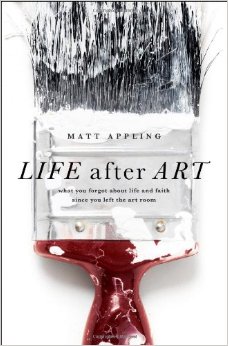 Life After Art: What You Forgot About Life and Faith Since You Left the Art Room Matt Appling (Moody) $13.99 We stock all the recent books in the recent imprint the “Moody Collective” which are written by younger adults, energetic volumes with an Millennial edge, deeply Christian but not pushy, well written and artful. So it makes perfect sense that the Collective would do a book about the creative passions that so many younger adults long for. (And others, too; recall that Doug Pagitt says we now live in “the inventive age.”) This nice volume is, interestingly, as cool as their others, but has an appeal to readers of any age. The topic is a commonly discussed theme – how school and grown- up life seems to squeeze the playful creativity of childhood out of us – but I know of no other book that reflects on this from a Christian viewpoint. I love the blurb on the back by Anne Jackson, who explains that “Matt takes readers on a journey to the art room to discover our purpose in life, which can be found in our God-given ability to create beauty for the world to see.” This is a book full of invitation, beauty, grace, and being set free to care about all this more. I should have listed it in my list of books last months about leisure and play. Very nice.
Life After Art: What You Forgot About Life and Faith Since You Left the Art Room Matt Appling (Moody) $13.99 We stock all the recent books in the recent imprint the “Moody Collective” which are written by younger adults, energetic volumes with an Millennial edge, deeply Christian but not pushy, well written and artful. So it makes perfect sense that the Collective would do a book about the creative passions that so many younger adults long for. (And others, too; recall that Doug Pagitt says we now live in “the inventive age.”) This nice volume is, interestingly, as cool as their others, but has an appeal to readers of any age. The topic is a commonly discussed theme – how school and grown- up life seems to squeeze the playful creativity of childhood out of us – but I know of no other book that reflects on this from a Christian viewpoint. I love the blurb on the back by Anne Jackson, who explains that “Matt takes readers on a journey to the art room to discover our purpose in life, which can be found in our God-given ability to create beauty for the world to see.” This is a book full of invitation, beauty, grace, and being set free to care about all this more. I should have listed it in my list of books last months about leisure and play. Very nice.
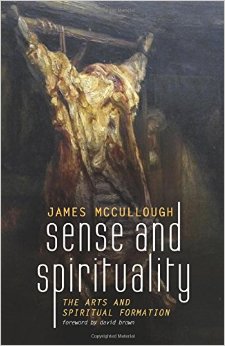 Sense and Spirituality: The Arts and Spiritual Formation James McCullough (Cascade) $18.00 McCullough has his PhD from the Institute for Theology, Imagination, and the Arts at the University of St. Andrews so you know this is some serious, meaty stuff. He has published articles on the music of Anton Bruckner as well as the art of Graham Sutherland and Makoto Fujimura. This book attempts to explore some new grounds, not just deepening our faithful understanding of aesthetics, nor the general conversation about faith and the arts, or church ministry among artists. This work is hoping to advance our insights about “how the arts might actually advance spiritual formation in terms of the cumulative effect of religious experience and intentional practices.” It naturally offers more to the discussion between theological aesthetics and practical theology, but, more, it offers an analysis of artistic communication and how music, poetry, and painting can help us in our spiritual formation. Can our experience of the presence of God be animated by our appreciation of aesthetics and by our actual engagement with art? As Wheaton art professor Matthew Milliner says in his back cover review, “McCullough deftly calls attention to the elephant in the elephant in the aesthetic seminar room: the way that art catalyzes spiritual growth.”
Sense and Spirituality: The Arts and Spiritual Formation James McCullough (Cascade) $18.00 McCullough has his PhD from the Institute for Theology, Imagination, and the Arts at the University of St. Andrews so you know this is some serious, meaty stuff. He has published articles on the music of Anton Bruckner as well as the art of Graham Sutherland and Makoto Fujimura. This book attempts to explore some new grounds, not just deepening our faithful understanding of aesthetics, nor the general conversation about faith and the arts, or church ministry among artists. This work is hoping to advance our insights about “how the arts might actually advance spiritual formation in terms of the cumulative effect of religious experience and intentional practices.” It naturally offers more to the discussion between theological aesthetics and practical theology, but, more, it offers an analysis of artistic communication and how music, poetry, and painting can help us in our spiritual formation. Can our experience of the presence of God be animated by our appreciation of aesthetics and by our actual engagement with art? As Wheaton art professor Matthew Milliner says in his back cover review, “McCullough deftly calls attention to the elephant in the elephant in the aesthetic seminar room: the way that art catalyzes spiritual growth.”
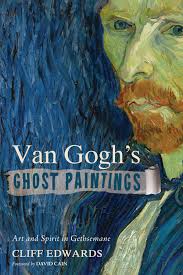 Van Gogh’s Ghost Paintings: Art and Spiritual in Gethsemane Cliff Edwards (Cascade Books) $16.00 Edwards is a fascinating author, having done books on Japanese haiku, and several previous books on the faith life of Van Gogh and his paintings. I wish this had come out in time for CIVA; it arrived just after the conference, so here it sits, lovely, beckoning. Elizabeth King, a sculptor who won a Guggenheim Fellowship and a recipient of the Academy Award of the American Academy of Arts and Letters says “This is a superb work. The author’s fearless journey into the life of Van Gogh and the interiority of the writing take the readers herself into solitude, loneliness, labor, triumph, and sorrow. It is a complex work… we treat with this book the very path Van Gogh himself hesitate3d on and wrestled with himself on: the seeming contradiction between the intellect and the spirit in art. Obviously, the Dutch painter remains one with whom we resonate. Even Henri Nouwen, who drew so tenderly from Van Gogh, has esteemed Mr. Edwards contributions to Van Gogh studies.
Van Gogh’s Ghost Paintings: Art and Spiritual in Gethsemane Cliff Edwards (Cascade Books) $16.00 Edwards is a fascinating author, having done books on Japanese haiku, and several previous books on the faith life of Van Gogh and his paintings. I wish this had come out in time for CIVA; it arrived just after the conference, so here it sits, lovely, beckoning. Elizabeth King, a sculptor who won a Guggenheim Fellowship and a recipient of the Academy Award of the American Academy of Arts and Letters says “This is a superb work. The author’s fearless journey into the life of Van Gogh and the interiority of the writing take the readers herself into solitude, loneliness, labor, triumph, and sorrow. It is a complex work… we treat with this book the very path Van Gogh himself hesitate3d on and wrestled with himself on: the seeming contradiction between the intellect and the spirit in art. Obviously, the Dutch painter remains one with whom we resonate. Even Henri Nouwen, who drew so tenderly from Van Gogh, has esteemed Mr. Edwards contributions to Van Gogh studies.
BookNotes
DISCOUNT
ANY ITEM MENTIONED
20% off
order here
takes you to the secure Hearts & Minds order form page
just tell us what you want
inquire here
if you have questions or need more information
just ask us what you want to know
Hearts & Minds 234 East Main Street Dallastown, PA 17313 717-246-3333

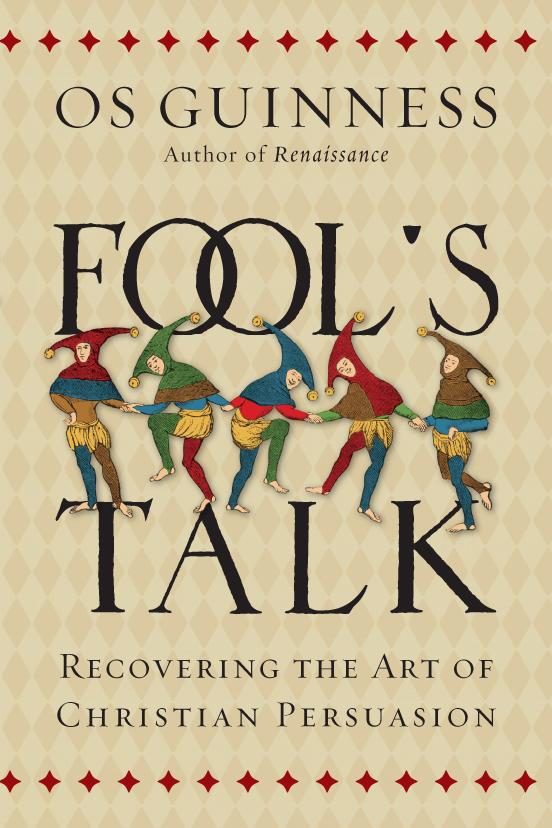

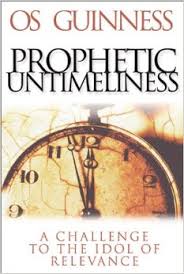
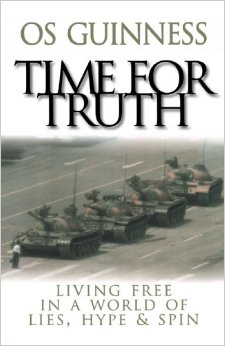
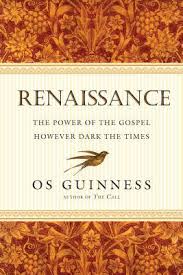
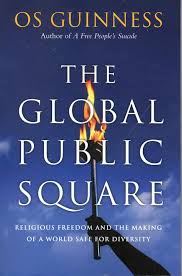
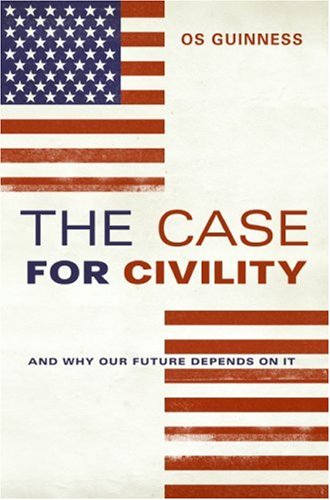 a sociologist with a PhD earned under the eminent Peter Berger, media pundit (who did a stint with the BBC), founder of bi-partisan project designed to deepen American’s appreciation for first amendment freedoms, advocating for structural reforms that promote pluralism, religious diversity and which enhance civility. His hard-hitting book Case for Civility was about much more than public manners but offered positive plans for enhancing better public discourse and stability in the public square. His pair of meaty books A Free People’s Suicide and The Global Public Square reflected, respectively, on the threats to religious freedom in North America, and globally. Dr. Guinness has even addressed United Nations diplomats on this topic of religious freedom, inviting them to help “make the world safe for
a sociologist with a PhD earned under the eminent Peter Berger, media pundit (who did a stint with the BBC), founder of bi-partisan project designed to deepen American’s appreciation for first amendment freedoms, advocating for structural reforms that promote pluralism, religious diversity and which enhance civility. His hard-hitting book Case for Civility was about much more than public manners but offered positive plans for enhancing better public discourse and stability in the public square. His pair of meaty books A Free People’s Suicide and The Global Public Square reflected, respectively, on the threats to religious freedom in North America, and globally. Dr. Guinness has even addressed United Nations diplomats on this topic of religious freedom, inviting them to help “make the world safe for 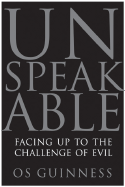 diversity.” A major book, Unspeakable: Facing Up to the Challenge of Evil, attempted to enter the conversation about theodicy, not so much to answer the big question of “why” but to offer a framework for thinking about large evils such as genocide or sexual trafficking. It is a hugely under-utilized book, and I cannot recommend it enough.
diversity.” A major book, Unspeakable: Facing Up to the Challenge of Evil, attempted to enter the conversation about theodicy, not so much to answer the big question of “why” but to offer a framework for thinking about large evils such as genocide or sexual trafficking. It is a hugely under-utilized book, and I cannot recommend it enough.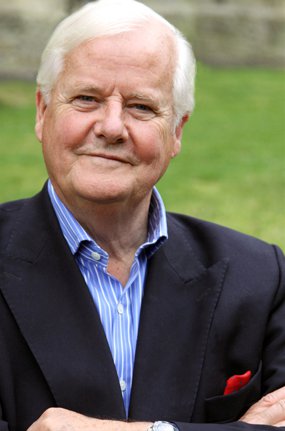 books about evangelism have rarely actually led another to lasting faith and some who write about apologetics like to think about the logic of faith, but, again, may not have had much experience actually befriending skeptics and relating well to those who are hostile to Christian conviction. Although Guinness surely knows the benefit of scholars and thinkers and writers — he cites philosophers and scholarly authors on every page! — he is right that bookish guidance about doing this kind of work simply must be field tested and refined by real conversations, with real people, knowing real failures, sometimes through heartache and tears, even. The topic demands real pages written after years of experience and genuine concern. Guinness writes that he has waited 40 years to write this book.
books about evangelism have rarely actually led another to lasting faith and some who write about apologetics like to think about the logic of faith, but, again, may not have had much experience actually befriending skeptics and relating well to those who are hostile to Christian conviction. Although Guinness surely knows the benefit of scholars and thinkers and writers — he cites philosophers and scholarly authors on every page! — he is right that bookish guidance about doing this kind of work simply must be field tested and refined by real conversations, with real people, knowing real failures, sometimes through heartache and tears, even. The topic demands real pages written after years of experience and genuine concern. Guinness writes that he has waited 40 years to write this book. 
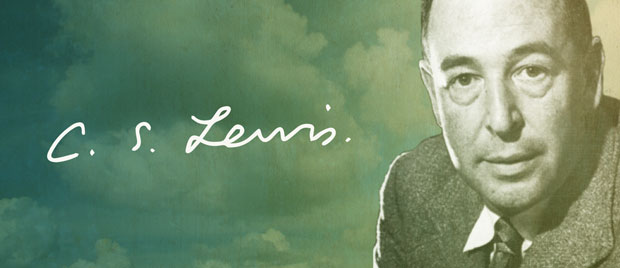

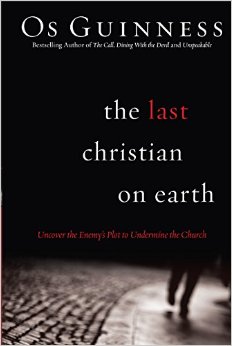 assumptions in the late modern West and the need of the church to be newly faithful. This was, if I might, the How (Not) To Be Secular: Reading Charles Taylor [by James K.A. Smith] of the 1980s, prescient and profound, clever as it was. Looking back, playfully, it could have almost been called “How (Not) To Be Secular: Reading Peter Berger.” It was edited, expanded and re-issued in 2010 under the title The Last Christian On Earth: Uncovering the Enemy’s Plot to Undermine the Church (Baker; $17.00.) We found it hard to describe and hard to sell, but it is – I’m not kidding! – a wonderfully thoughtful read, a bit of parable, a bit of cultural exegesis, a playful example of some of what Guinness explores in this new Fools Talk: the need to deeply understand the cultural forces that shape how people think and see and understand and live in this culture, and the need to use humor, satire, and “turning the tables” as a form of apologetics. In Gravedigger cum The Last Christian On Earth Guinness does just that.
assumptions in the late modern West and the need of the church to be newly faithful. This was, if I might, the How (Not) To Be Secular: Reading Charles Taylor [by James K.A. Smith] of the 1980s, prescient and profound, clever as it was. Looking back, playfully, it could have almost been called “How (Not) To Be Secular: Reading Peter Berger.” It was edited, expanded and re-issued in 2010 under the title The Last Christian On Earth: Uncovering the Enemy’s Plot to Undermine the Church (Baker; $17.00.) We found it hard to describe and hard to sell, but it is – I’m not kidding! – a wonderfully thoughtful read, a bit of parable, a bit of cultural exegesis, a playful example of some of what Guinness explores in this new Fools Talk: the need to deeply understand the cultural forces that shape how people think and see and understand and live in this culture, and the need to use humor, satire, and “turning the tables” as a form of apologetics. In Gravedigger cum The Last Christian On Earth Guinness does just that.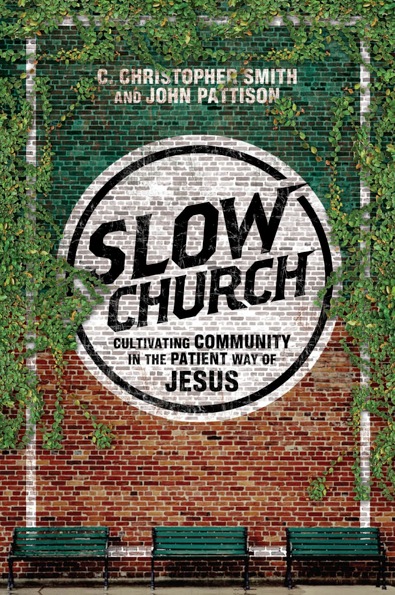
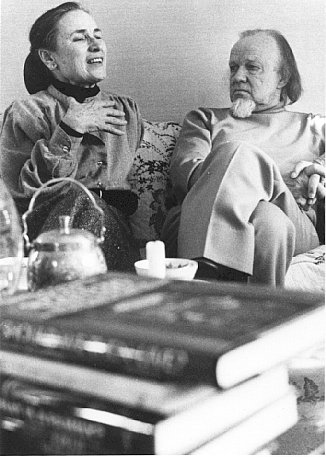 Francis and Edith Schaeffer who were renowned for the great care and individualized pastoral and apologetic counsel offered in the context of welcoming hospitality that they would give to each and every person they encountered. Guinness is adamant about this and while is seems so obvious that it hardly needs saying, it does need saying. And he says it strongly, even denouncing the “imperialism of technique” and “McTheories.”
Francis and Edith Schaeffer who were renowned for the great care and individualized pastoral and apologetic counsel offered in the context of welcoming hospitality that they would give to each and every person they encountered. Guinness is adamant about this and while is seems so obvious that it hardly needs saying, it does need saying. And he says it strongly, even denouncing the “imperialism of technique” and “McTheories.” 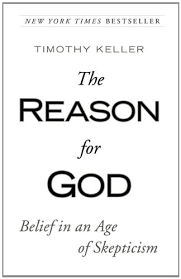 deconstructions (one complex chapter is called “turning the tables”) and with wit and kindness but sometimes also hard words spoken well, help skeptics doubt their doubts. (Timothy Keller writes about this clearly in his important and useful Reason for God: Belief in an Age of Skepticism.) Guinness uses examples from Lewis, Schaeffer and Berger about doing just this — it is thoughtful, provocative, and finally practical. I love, for instance, his guidance about moving our discernment about the journey of our conversation partners from a meeting point to a pressure point to a danger point, where they are inevitably forced to wrestle with deep things about their deepest convictions and concerns, and realize the consequences of their ideas and beliefs, or lack thereof.
deconstructions (one complex chapter is called “turning the tables”) and with wit and kindness but sometimes also hard words spoken well, help skeptics doubt their doubts. (Timothy Keller writes about this clearly in his important and useful Reason for God: Belief in an Age of Skepticism.) Guinness uses examples from Lewis, Schaeffer and Berger about doing just this — it is thoughtful, provocative, and finally practical. I love, for instance, his guidance about moving our discernment about the journey of our conversation partners from a meeting point to a pressure point to a danger point, where they are inevitably forced to wrestle with deep things about their deepest convictions and concerns, and realize the consequences of their ideas and beliefs, or lack thereof.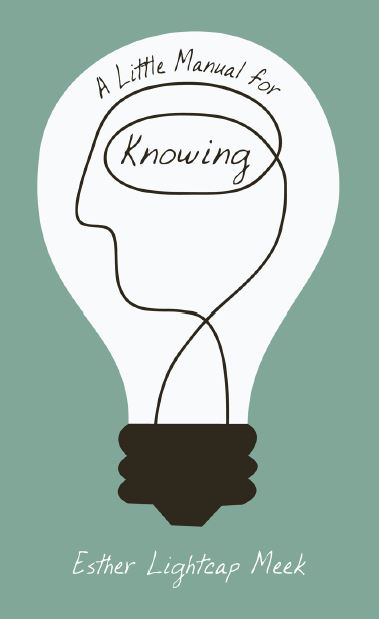
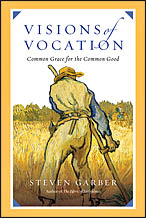 You may know how Steve Garber has ruminated on this, first in his significant Fabric of Faithfulness and again in the exceptional and profound Visions of Vocation; or how philosopher Esther Meeks has appropriated the work of Nobel Prize winning scientist Michael Polanyi in her Longing to Know: The Philosophy of Knowledge for Ordinary People or her Little Manuel of Knowing or her massive Loving to Know: Covenantal Epistemology. Guinness does not reference Garber or Meeks, but he might have.)
You may know how Steve Garber has ruminated on this, first in his significant Fabric of Faithfulness and again in the exceptional and profound Visions of Vocation; or how philosopher Esther Meeks has appropriated the work of Nobel Prize winning scientist Michael Polanyi in her Longing to Know: The Philosophy of Knowledge for Ordinary People or her Little Manuel of Knowing or her massive Loving to Know: Covenantal Epistemology. Guinness does not reference Garber or Meeks, but he might have.)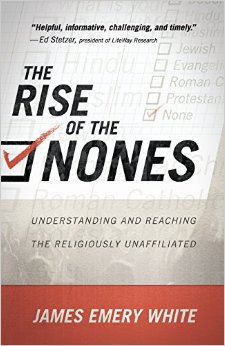
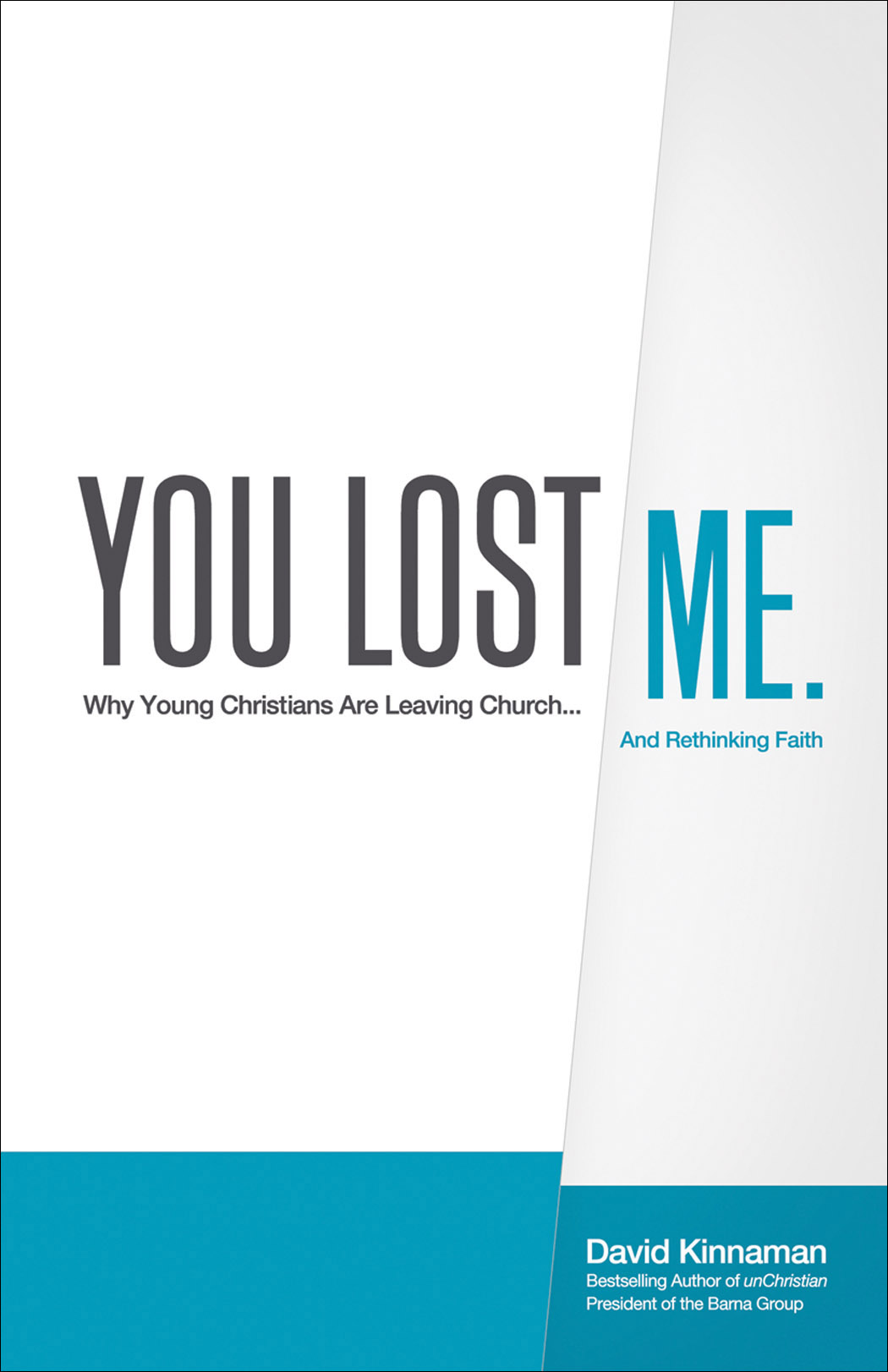
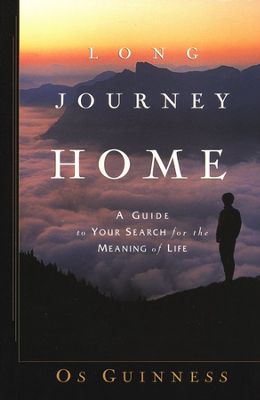 yet” to the invitation to understand that Meaning-giver as the God of the Bible, incarnate in Jesus the Christ. People may “fall on their knees or turn on their heels.” Like in his wonderfully rich book for seekers called The Long Journey Home: A Guide to Your Search for the Meaning of Life (WaterBrook; $18.99) Guinness helps us chart the journey of our conversation partners, helping them do some ruthlessly honest self appraisal, realizing that signals of transcendence may not immediately draw skeptics to faith. (That is why we need “spring loaded” dynamics, asking probing questions, and the tools of wit and irony and even the ploys of good drama to push and pull our friends to deeper questions and new plausibilities and finally new answers.)
yet” to the invitation to understand that Meaning-giver as the God of the Bible, incarnate in Jesus the Christ. People may “fall on their knees or turn on their heels.” Like in his wonderfully rich book for seekers called The Long Journey Home: A Guide to Your Search for the Meaning of Life (WaterBrook; $18.99) Guinness helps us chart the journey of our conversation partners, helping them do some ruthlessly honest self appraisal, realizing that signals of transcendence may not immediately draw skeptics to faith. (That is why we need “spring loaded” dynamics, asking probing questions, and the tools of wit and irony and even the ploys of good drama to push and pull our friends to deeper questions and new plausibilities and finally new answers.)
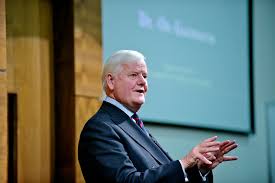
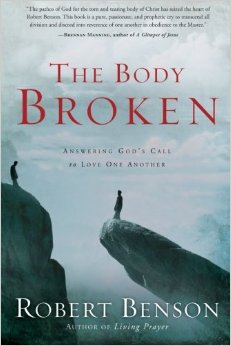
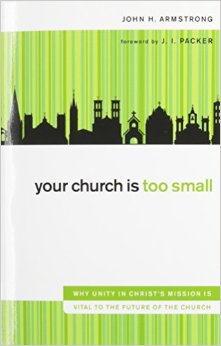
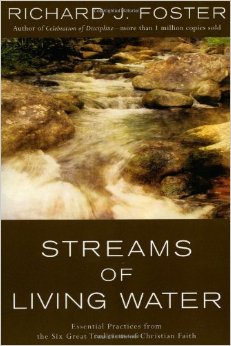 hotbeds of theological diversity, but more varied then most folks admit. To use Richard Foster’s helpful image, some of us have been refreshed by more than one “stream” or type of Christianity.
hotbeds of theological diversity, but more varied then most folks admit. To use Richard Foster’s helpful image, some of us have been refreshed by more than one “stream” or type of Christianity. 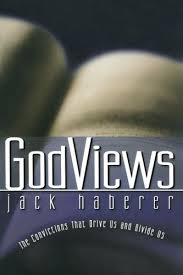 Some tensions within our churches come from what one might say are worldview differences. Jack Haberer years ago studied Presbyterian churches and learned that some members in the same congregation most valued creedal faithfulness, others vibrant worship, others still are glad if their church gives them opportunity for meaningful mission, etc. If you are a relational type and you have dear sisters and brothers, you may not mind a bad sermon. If you are deeply involved in rewarding volunteer work with youth, say, and see vibrant youngsters maturing in faith, you may not care if you like the music in worship or not. That is, what people most want in a church, what they think most counts, emerges from deep assumptions. It may be helpful to explore what we most think of when we think of good faith or a good church to discover why what agitates one person isn’t a big deal to another. That book was called GodViews: The Convictions That Drive Us and Divide Us (WJK; $20.00) and I think there is something to that.
Some tensions within our churches come from what one might say are worldview differences. Jack Haberer years ago studied Presbyterian churches and learned that some members in the same congregation most valued creedal faithfulness, others vibrant worship, others still are glad if their church gives them opportunity for meaningful mission, etc. If you are a relational type and you have dear sisters and brothers, you may not mind a bad sermon. If you are deeply involved in rewarding volunteer work with youth, say, and see vibrant youngsters maturing in faith, you may not care if you like the music in worship or not. That is, what people most want in a church, what they think most counts, emerges from deep assumptions. It may be helpful to explore what we most think of when we think of good faith or a good church to discover why what agitates one person isn’t a big deal to another. That book was called GodViews: The Convictions That Drive Us and Divide Us (WJK; $20.00) and I think there is something to that. friendships lost and lamented in The Big Chill or who came of age watching Thirty-Something or even Parenthood, we long for deep relationships, lasting loyalties, and meaningful friendships. (Do you recall
friendships lost and lamented in The Big Chill or who came of age watching Thirty-Something or even Parenthood, we long for deep relationships, lasting loyalties, and meaningful friendships. (Do you recall 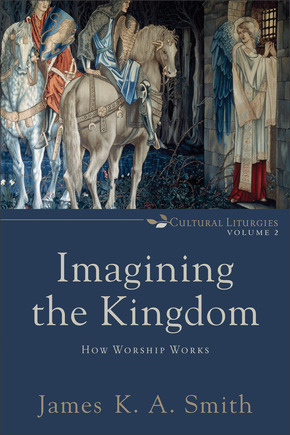
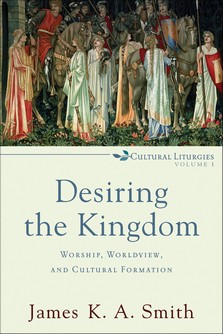 (For deeper explorations of this, by the way, how the rituals of Christian liturgy form us, please see James K.A. Smith’s Desiring the Kingdom: Worship, Worldview, and Cultural Formation and Imagining the Kingdom: How Worship Works (Baker; $22.99 each.) I can’t tell — although I’ve tried in these pages and elsewhere — how very important these serious works are.)
(For deeper explorations of this, by the way, how the rituals of Christian liturgy form us, please see James K.A. Smith’s Desiring the Kingdom: Worship, Worldview, and Cultural Formation and Imagining the Kingdom: How Worship Works (Baker; $22.99 each.) I can’t tell — although I’ve tried in these pages and elsewhere — how very important these serious works are.) Life Together Dietrich Bonhoeffer (HarperOne) $14.99 Bonhoeffer, you may know, wrote his PhD thesis on the nature of the church (perhaps inspired by an epiphany he had about the profound nature of ecclesiology while worshipping once on Palm Sunday in Rome.) His call to radical discipleship and loving service for the sake of the world is deeply interwoven with his views of the forming power of the local Christian church. This is, as the cover rightly proclaims, “The Classic Exploration of Christian Community.” Not many books have endorsing blurbs on the back by Richard Foster, Henri Nouwen, and The New York Times, so I hope you realize this is truly one of the great books of our time. Serious, brief, powerful. It’s a must-read that should be available in your church library and on your shelf.
Life Together Dietrich Bonhoeffer (HarperOne) $14.99 Bonhoeffer, you may know, wrote his PhD thesis on the nature of the church (perhaps inspired by an epiphany he had about the profound nature of ecclesiology while worshipping once on Palm Sunday in Rome.) His call to radical discipleship and loving service for the sake of the world is deeply interwoven with his views of the forming power of the local Christian church. This is, as the cover rightly proclaims, “The Classic Exploration of Christian Community.” Not many books have endorsing blurbs on the back by Richard Foster, Henri Nouwen, and The New York Times, so I hope you realize this is truly one of the great books of our time. Serious, brief, powerful. It’s a must-read that should be available in your church library and on your shelf.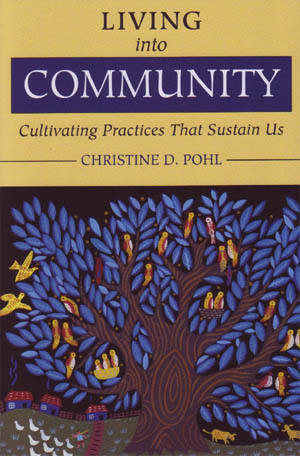 Living into Community: Cultivating Practices That Sustain Us Christian D. Pohl (Eerdmans) $20.00 A thoroughly captivating, fascinating, wise and important book for any educated reader. It is in many ways beautiful, naming and exploring four essential practices that sustain a sense of community, and the obstacles of living into them in these days. This is so good, there is really nothing quite like it in print, making it a must-have, must read book. In a way is a follow up to Pohl’s very important and equally wonderful work on hospitality, Making Room: Recovering Hospitality as a Christian Tradition (Eerdmans; $21.00) Yes!
Living into Community: Cultivating Practices That Sustain Us Christian D. Pohl (Eerdmans) $20.00 A thoroughly captivating, fascinating, wise and important book for any educated reader. It is in many ways beautiful, naming and exploring four essential practices that sustain a sense of community, and the obstacles of living into them in these days. This is so good, there is really nothing quite like it in print, making it a must-have, must read book. In a way is a follow up to Pohl’s very important and equally wonderful work on hospitality, Making Room: Recovering Hospitality as a Christian Tradition (Eerdmans; $21.00) Yes!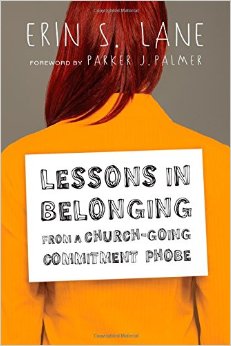 Lessons in Belonging: From a Church-Going Commitment Phobe Erin S. Lane (IVP) $16.00 I have raved about this book before, and think it should be high on the list of books you read about how the local church can be a place of deeper relationships and community. The author is a heck of a great writer — young, a bit snarky, not exactly as colorful as Anne Lamott, say, but equally as funny, she is energetic and wonderfully able to craft very creative, entertaining sentences. Her story — as a hip, young woman, married to a young pastor — follows her own ambivalence about commitment. She calls herself a “commitment phobe” and although that sounds like some generational stereotype, the concerns are real for many of us — introverts and skeptics and those who have been hurt or fear deeper friendships. This is a good, smart book about the ups and downs of belonging, even to a small, normal church, and I recommend it highly. There is a great foreword by her friend and mentor, Quaker writer Parker Palmer. Phyllis Tickle says “One of the clearest and certainly one of the most informing pictures I have seen to date of the generation of young adults who presently are shaping the twenty-first century church.”
Lessons in Belonging: From a Church-Going Commitment Phobe Erin S. Lane (IVP) $16.00 I have raved about this book before, and think it should be high on the list of books you read about how the local church can be a place of deeper relationships and community. The author is a heck of a great writer — young, a bit snarky, not exactly as colorful as Anne Lamott, say, but equally as funny, she is energetic and wonderfully able to craft very creative, entertaining sentences. Her story — as a hip, young woman, married to a young pastor — follows her own ambivalence about commitment. She calls herself a “commitment phobe” and although that sounds like some generational stereotype, the concerns are real for many of us — introverts and skeptics and those who have been hurt or fear deeper friendships. This is a good, smart book about the ups and downs of belonging, even to a small, normal church, and I recommend it highly. There is a great foreword by her friend and mentor, Quaker writer Parker Palmer. Phyllis Tickle says “One of the clearest and certainly one of the most informing pictures I have seen to date of the generation of young adults who presently are shaping the twenty-first century church.” 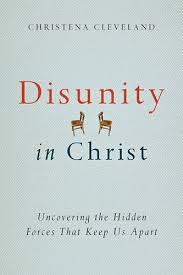 Disunity in Christ:Uncovering the Hidden Forces That Keep Us Apart Christena Cleveland (IVP) $16.00 I’ve given enthusiastic shout-outs about this before, in print, and at events, hoping that many will want to grapple with this great book. It is not the only book about the things that divide us such as race and class and gender, but it is perhaps the best. It is great because Ms Cleveland is Biblically-grounded, clear, and also because she is, interestingly, upbeat and even humorous. Heady, heavy, liberationist hermeneutics about class and gender may appeal to liberal academics, but most of us – whether we are in mainline churches or evangelical fellowships- need encouragement, challenge, inspiration, and useful guidance. Cleveland is an African American sociologist and teacher, and is well suited to help us navigate this provocative stuff, and she does it really well. She tells good stories, offers keen insight, pushes us a bit, and invites God to guide us into deeper unity and mature diversity. I love this author and her good book, and believe it will help us uncover hidden influences, allowing us to move in healthy directions, for God’s glory. Please, read this book! You’re sense of community can only be enhanced by exploring how even our conversational patterns can be off putting, and how learning some cross-cultural awareness can help. Cleveland is
Disunity in Christ:Uncovering the Hidden Forces That Keep Us Apart Christena Cleveland (IVP) $16.00 I’ve given enthusiastic shout-outs about this before, in print, and at events, hoping that many will want to grapple with this great book. It is not the only book about the things that divide us such as race and class and gender, but it is perhaps the best. It is great because Ms Cleveland is Biblically-grounded, clear, and also because she is, interestingly, upbeat and even humorous. Heady, heavy, liberationist hermeneutics about class and gender may appeal to liberal academics, but most of us – whether we are in mainline churches or evangelical fellowships- need encouragement, challenge, inspiration, and useful guidance. Cleveland is an African American sociologist and teacher, and is well suited to help us navigate this provocative stuff, and she does it really well. She tells good stories, offers keen insight, pushes us a bit, and invites God to guide us into deeper unity and mature diversity. I love this author and her good book, and believe it will help us uncover hidden influences, allowing us to move in healthy directions, for God’s glory. Please, read this book! You’re sense of community can only be enhanced by exploring how even our conversational patterns can be off putting, and how learning some cross-cultural awareness can help. Cleveland is 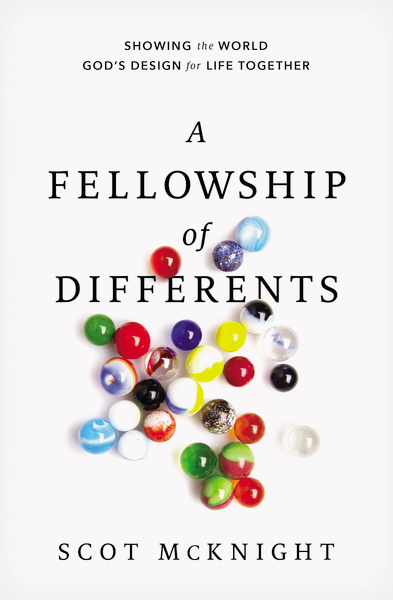 A Fellowship of Differents: Showing the World God’s Design for Life Together Scot McKnight (Zondervan) $19.99 Dr. McKnight is a major, evangelical, Bible scholar, one who has written detailed commentaries and academic work, as well has helpful books for on everything from fasting to praying the hours to the ethics of following Jesus to interpreting the Bible. We regularly promote his One.Life and (mostly positively) reviewed his important The Kingdom Conspiracy. Here he is doing what he sometimes does – offers mature and informed scholarship in chatty, upbeat, funny and sensible ways, making it informative and inspiring. I like McKnight a lot and really appreciate his insistence in this book that our local congregations should be more diverse, less homogeneous, more gracious, a place where we learn to live together, witnessing to the world about the peace that passes understanding. The title is a great one, eh? In a few chapters, McKnight gets at this as well as any other book, and speaks bold truth, even hard truth, in ways that seem natural and do-able. Thanks be to God for this good brother and his generous vision of a diverse church and his explaining how the glories of the reign of God must be known and shown in the local church, where people flourish and grace is experienced and diversity is event, even as a deeper unity is celebrated and broken relationships are healed. Yet, I must say, a few of these chapters – as good as they are – drift off into what I might call “basic Christian growth” offering (very) good insight for daily discipleship but seeming to be not terribly connected to the basic point of the book. I am not sure I agree with the blurb on the back by Derwin Gray (“This is the most important book you may ever read outside of the Bible”) but it does indicate that it is exceptionally useful. Christena Cleveland says “Anyone who desires unity with all of God’s people, not just the ones who are most like us, will be emboldened by this book.” Let’s hope!
A Fellowship of Differents: Showing the World God’s Design for Life Together Scot McKnight (Zondervan) $19.99 Dr. McKnight is a major, evangelical, Bible scholar, one who has written detailed commentaries and academic work, as well has helpful books for on everything from fasting to praying the hours to the ethics of following Jesus to interpreting the Bible. We regularly promote his One.Life and (mostly positively) reviewed his important The Kingdom Conspiracy. Here he is doing what he sometimes does – offers mature and informed scholarship in chatty, upbeat, funny and sensible ways, making it informative and inspiring. I like McKnight a lot and really appreciate his insistence in this book that our local congregations should be more diverse, less homogeneous, more gracious, a place where we learn to live together, witnessing to the world about the peace that passes understanding. The title is a great one, eh? In a few chapters, McKnight gets at this as well as any other book, and speaks bold truth, even hard truth, in ways that seem natural and do-able. Thanks be to God for this good brother and his generous vision of a diverse church and his explaining how the glories of the reign of God must be known and shown in the local church, where people flourish and grace is experienced and diversity is event, even as a deeper unity is celebrated and broken relationships are healed. Yet, I must say, a few of these chapters – as good as they are – drift off into what I might call “basic Christian growth” offering (very) good insight for daily discipleship but seeming to be not terribly connected to the basic point of the book. I am not sure I agree with the blurb on the back by Derwin Gray (“This is the most important book you may ever read outside of the Bible”) but it does indicate that it is exceptionally useful. Christena Cleveland says “Anyone who desires unity with all of God’s people, not just the ones who are most like us, will be emboldened by this book.” Let’s hope! Building Up One Another Gene Getz (David C. Cook) $12.99 This little volume is a powerhouse of a paperback, a simple bit of Bible teaching by a fine evangelical leader (now consulting as the president of Center for Church Renewal.) This is a tremendous idea, each chapter a study of one of the many “one another” commands in the New Testament. He unpacks the meaning and offers simple suggestions for building up one another, serving one another, bearing with one another, even teaching on the seemingly mundane mandates like greeting one another. The study guide that is included is helpful, with some self-assessment questions, too. This will help us get beyond merely tolerating one another, but living into the truth of our being “members of one another.” Very practical, no-nonsense, practical.
Building Up One Another Gene Getz (David C. Cook) $12.99 This little volume is a powerhouse of a paperback, a simple bit of Bible teaching by a fine evangelical leader (now consulting as the president of Center for Church Renewal.) This is a tremendous idea, each chapter a study of one of the many “one another” commands in the New Testament. He unpacks the meaning and offers simple suggestions for building up one another, serving one another, bearing with one another, even teaching on the seemingly mundane mandates like greeting one another. The study guide that is included is helpful, with some self-assessment questions, too. This will help us get beyond merely tolerating one another, but living into the truth of our being “members of one another.” Very practical, no-nonsense, practical.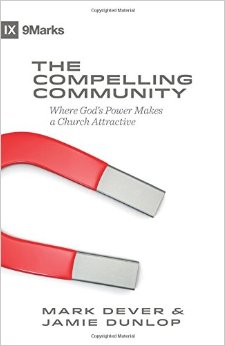 The Compelling Community: Where God’s Power Makes a Church Attractive Mark Dever & Jamie Dunlop (Crossway) $15.99 This new book is a very solid, conservatively evangelical study of how the gospel itself is what transforms a church. It contrasts the often frenzied efforts to “create” community and resists any pre-packaged plan or manipulation to develop deeper relationships with their sense that the preaching of the gospel, and a church being shaped by the historic marks of the church, will, with proper vision casting and gospel-centered teaching, become a body of those who truly love one another and reach out with hospitality and care to others. Dever and Dunlop are leaders at the thriving Capitol Hill Baptist and their church is nicely well known for their tight-knit community. They provide “an alternative to running your church on the building blocks of specialization and segmentation.” Designed mostly for church leaders — there are excellent pieces about structural matters in the congregations ethos or schedule that mitigate against the teaching of each chapter — this is a seriously Biblical call to authentic Christian community in the well-ordered, grace-based local congregation.
The Compelling Community: Where God’s Power Makes a Church Attractive Mark Dever & Jamie Dunlop (Crossway) $15.99 This new book is a very solid, conservatively evangelical study of how the gospel itself is what transforms a church. It contrasts the often frenzied efforts to “create” community and resists any pre-packaged plan or manipulation to develop deeper relationships with their sense that the preaching of the gospel, and a church being shaped by the historic marks of the church, will, with proper vision casting and gospel-centered teaching, become a body of those who truly love one another and reach out with hospitality and care to others. Dever and Dunlop are leaders at the thriving Capitol Hill Baptist and their church is nicely well known for their tight-knit community. They provide “an alternative to running your church on the building blocks of specialization and segmentation.” Designed mostly for church leaders — there are excellent pieces about structural matters in the congregations ethos or schedule that mitigate against the teaching of each chapter — this is a seriously Biblical call to authentic Christian community in the well-ordered, grace-based local congregation.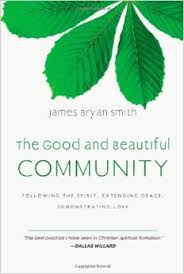 The Good and Beautiful Community: Following the Spirit, Extending Grace, Demonstrating Love James Bryan Smith (IVP) $23.00 Oh, how I hope you know this trilogy of books – the Apprentice Series. Dallas Willard says of them that they are “The best practice I have seen in Christian spiritual formation.” The first was The Good and Beautiful God followed by The Good and Beautiful Life. This third one, with good Bible study, helpful and inspiring insights, and practical “Soul Training” exercises, is all about the local church, the community in which we find ourselves, those to whom we belong and are bound together for spiritual formation and whole-life discipleship. Can we live out Galatians 5:6 – faith expressing itself through love? Can we create local faith communities that could honestly be called “good and beautiful”? One doesn’t have to read these books in order (although it may help.) Lovely, good, true.
The Good and Beautiful Community: Following the Spirit, Extending Grace, Demonstrating Love James Bryan Smith (IVP) $23.00 Oh, how I hope you know this trilogy of books – the Apprentice Series. Dallas Willard says of them that they are “The best practice I have seen in Christian spiritual formation.” The first was The Good and Beautiful God followed by The Good and Beautiful Life. This third one, with good Bible study, helpful and inspiring insights, and practical “Soul Training” exercises, is all about the local church, the community in which we find ourselves, those to whom we belong and are bound together for spiritual formation and whole-life discipleship. Can we live out Galatians 5:6 – faith expressing itself through love? Can we create local faith communities that could honestly be called “good and beautiful”? One doesn’t have to read these books in order (although it may help.) Lovely, good, true.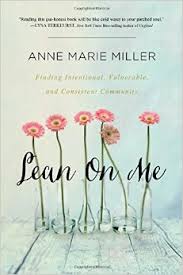 Lean on Me: Finding Intentional, Vulnerable, and Consistent Community Anne Marie Miller (Thomas Nelson) $15.99 I hope you know Miller, who wrote a the profoundly moving Permission to Speak Freely which is also about being vulnerable, real, gut-wrenchingly accepting within the local church. Here she tells her own story – itself worth reading – and draws helpful principles for renewal, committed, healing relationships. Upbeat, conversational, very interesting for those who appreciate such an honest, passionate voice. This is a great read and would make a nice choice for a book club.
Lean on Me: Finding Intentional, Vulnerable, and Consistent Community Anne Marie Miller (Thomas Nelson) $15.99 I hope you know Miller, who wrote a the profoundly moving Permission to Speak Freely which is also about being vulnerable, real, gut-wrenchingly accepting within the local church. Here she tells her own story – itself worth reading – and draws helpful principles for renewal, committed, healing relationships. Upbeat, conversational, very interesting for those who appreciate such an honest, passionate voice. This is a great read and would make a nice choice for a book club.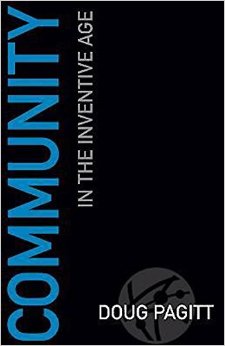 Community in the Inventive Age Doug Pagitt (Abingdon) $16.99 I love the way this book does some clear-headed, basic, cultural assessment – showing how things have shifted from the Agrarian Age, the Industrial Age, the Information Age and what kinds of churches tended to emerge in those social settings – helping us understand some of the contours of our own “inventive” era. He may or may not be fully right about this age of transition and how that means we must rethink leadership patterns and faith formation within the local congregation, but I assure you it is interesting and important material. Some serious sociologists might take exception to his quickly summarized categories and some serious theologians will think he’s a bit light-weight on stuff that matters most, but for a quick read to stir the pot, it is a very, very helpful manifesto. If you like Len Sweet’s early work, Phyllis Tickle’s cultural analysis, if you’ve followed the Emergent conversations, you will appreciate this insight gleaned from Pagitt’s own Solomon’s Porch, a wholistic missional community in Minneapolis. See also his Evangelism in the Inventive Age and Preaching in the Inventive Age. Very candid and creative about new ways to do church, based less on “bounded sets” but relationships.
Community in the Inventive Age Doug Pagitt (Abingdon) $16.99 I love the way this book does some clear-headed, basic, cultural assessment – showing how things have shifted from the Agrarian Age, the Industrial Age, the Information Age and what kinds of churches tended to emerge in those social settings – helping us understand some of the contours of our own “inventive” era. He may or may not be fully right about this age of transition and how that means we must rethink leadership patterns and faith formation within the local congregation, but I assure you it is interesting and important material. Some serious sociologists might take exception to his quickly summarized categories and some serious theologians will think he’s a bit light-weight on stuff that matters most, but for a quick read to stir the pot, it is a very, very helpful manifesto. If you like Len Sweet’s early work, Phyllis Tickle’s cultural analysis, if you’ve followed the Emergent conversations, you will appreciate this insight gleaned from Pagitt’s own Solomon’s Porch, a wholistic missional community in Minneapolis. See also his Evangelism in the Inventive Age and Preaching in the Inventive Age. Very candid and creative about new ways to do church, based less on “bounded sets” but relationships.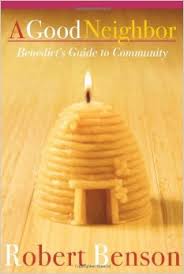 A Good Neighbor: Benedict’s Guide to Community Robert Benson (Paraclete) $14.99 I raved about Robert Benson as a writer and inspired, down-to-Earth spiritual guide in the last BookNotes post, telling about his poignant book lamenting our denominational disunity, The Body Broken. Here, he offers a too brief, splendidly written, truly lovely meditation on meaningful connections — in your small group, in your neighborhood, amongst your friends, and of course in your own local congregation, drawing on the ancient Rule of St Benedict of Nursia. Most of us, he explains, are involved with many people, mostly all day long, but still feel disconnected, even lonely. As it says on the back A Good Neighbor “takes an intimate look at how others are defining, discovering, nurturing, and sustaining life and love right where you are. Facing the confusing contradictions of modern life head on, Benson shows what it means to live in our neighborhoods, work at our jobs, be family, and be friends, in ways that builds places of relationships, love, and mutual support.” I adore this gentle guide to Benedictine views of promises and belonging and service to and with one another; what is interesting, and what sets this book apart somewhat from most others on this list, is that, in Benson’s hands, this monastic vision drawn from the Rule is applied to ordinary life for ordinary folk, less about forming “a” community (at church, in a small group, in an intentional community household) but more about being open to deep friendships and a sense of belonging to one another in various spheres of life and in various locations. He talks about how people are “given” to us — those who routinely cross our paths or are in some sort of relationship, gently giving a holy obligation to see each as a gift. What a lovely, lovely, book!
A Good Neighbor: Benedict’s Guide to Community Robert Benson (Paraclete) $14.99 I raved about Robert Benson as a writer and inspired, down-to-Earth spiritual guide in the last BookNotes post, telling about his poignant book lamenting our denominational disunity, The Body Broken. Here, he offers a too brief, splendidly written, truly lovely meditation on meaningful connections — in your small group, in your neighborhood, amongst your friends, and of course in your own local congregation, drawing on the ancient Rule of St Benedict of Nursia. Most of us, he explains, are involved with many people, mostly all day long, but still feel disconnected, even lonely. As it says on the back A Good Neighbor “takes an intimate look at how others are defining, discovering, nurturing, and sustaining life and love right where you are. Facing the confusing contradictions of modern life head on, Benson shows what it means to live in our neighborhoods, work at our jobs, be family, and be friends, in ways that builds places of relationships, love, and mutual support.” I adore this gentle guide to Benedictine views of promises and belonging and service to and with one another; what is interesting, and what sets this book apart somewhat from most others on this list, is that, in Benson’s hands, this monastic vision drawn from the Rule is applied to ordinary life for ordinary folk, less about forming “a” community (at church, in a small group, in an intentional community household) but more about being open to deep friendships and a sense of belonging to one another in various spheres of life and in various locations. He talks about how people are “given” to us — those who routinely cross our paths or are in some sort of relationship, gently giving a holy obligation to see each as a gift. What a lovely, lovely, book!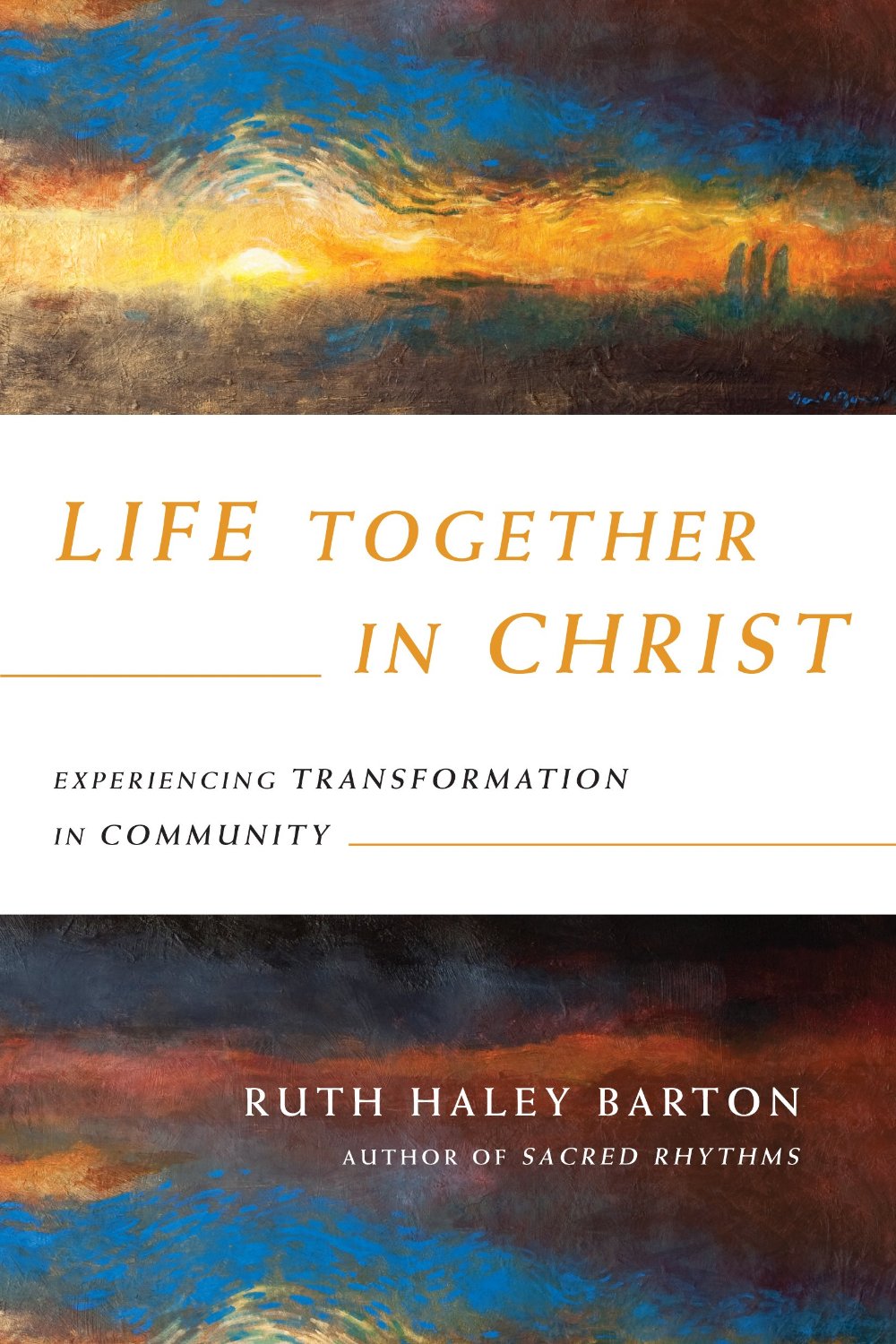 Life Together in Christ: Experiencing Transformation in Community Ruth Haley Barton (IVP) $18.00 While this book is initially, mostly, about spiritual formation – learning to practice the classic disciplines, creating “sacred rhythms” in order to experience God’s gentle transformation as we encounter the centering Spirit – it insists that this happens best when we are in community. In many ways, Ruth has been one of our best guides into the inner life, in her great books In Search of Silence and Solitude and Sacred Rhythms and Deepening the Soul of Your Leadership. However, here she brings these insights and invitations to a transformed life into the context of an intimate community, offering guidance for small groups who want to do this inner work together. My, my, this is sweet, challenging, vital material, fabulous for any small group wanting to experience God, opening themselves to spiritual transformation together.
Life Together in Christ: Experiencing Transformation in Community Ruth Haley Barton (IVP) $18.00 While this book is initially, mostly, about spiritual formation – learning to practice the classic disciplines, creating “sacred rhythms” in order to experience God’s gentle transformation as we encounter the centering Spirit – it insists that this happens best when we are in community. In many ways, Ruth has been one of our best guides into the inner life, in her great books In Search of Silence and Solitude and Sacred Rhythms and Deepening the Soul of Your Leadership. However, here she brings these insights and invitations to a transformed life into the context of an intimate community, offering guidance for small groups who want to do this inner work together. My, my, this is sweet, challenging, vital material, fabulous for any small group wanting to experience God, opening themselves to spiritual transformation together.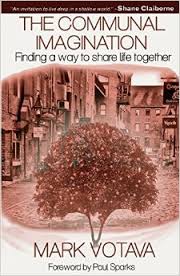
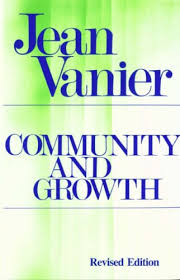 Community and Growth Jean Vanier (Paulist Press) $22.95 I do not know if most ordinary church folks will want to wade through this thick and important work, but you should know it, and realize it is perhaps the best thing written in our time about deepening serious, intentional community. You may know Jean Vanier as the gentle, French Canadian who started the L’Arche communities (that so attracted Henri Nouwen in the last years of his life) which forms community with persons with disabilities. Here, he draws on ancient monastic wisdom, psychological and spiritual insights, and invites us to give ourselves to one another in service and care. Anyone living in any sort of intentional community household must know this, and anyone longing for the deepest sort of communal experience will benefit. This is a masterpiece.
Community and Growth Jean Vanier (Paulist Press) $22.95 I do not know if most ordinary church folks will want to wade through this thick and important work, but you should know it, and realize it is perhaps the best thing written in our time about deepening serious, intentional community. You may know Jean Vanier as the gentle, French Canadian who started the L’Arche communities (that so attracted Henri Nouwen in the last years of his life) which forms community with persons with disabilities. Here, he draws on ancient monastic wisdom, psychological and spiritual insights, and invites us to give ourselves to one another in service and care. Anyone living in any sort of intentional community household must know this, and anyone longing for the deepest sort of communal experience will benefit. This is a masterpiece.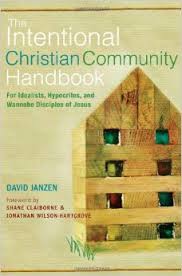 The Intentional Christian Community Handbook: For Idealists, Hypocrites, and Wannabe Disciples of Jesus David Janzen (Paraclete) $19.99 This is another book that simply has to be on this list — it is really the only and very best book of its kind — event though it has, admittedly, a pretty small market. This is a wonderful guidebook for those who want to live together in intentional community, doing house-holding together, maybe drawing on new monastic insights, forming relationships shaped by common rules and practices. The foreword is by Shane Claiborne and Jonathan Wilson-Hartgrove, which will give you a hint of its vision. Janzen (who graduated from Bethel College and studied at Harvard Divinity School) has been part of significant intentional communities such as New Creation Fellowship and Reba Place Fellowship. Whether you are interested in “living together in a world falling apart” or have any sort of housing ministry — maybe a discipleship house, a Fellows community, a camping staff that live together, or a house or cell church — this is going to be really useful. There are tons of good stories, interviews, wise guidance and substantive input about being in intentional community and deeper levels of body life.
The Intentional Christian Community Handbook: For Idealists, Hypocrites, and Wannabe Disciples of Jesus David Janzen (Paraclete) $19.99 This is another book that simply has to be on this list — it is really the only and very best book of its kind — event though it has, admittedly, a pretty small market. This is a wonderful guidebook for those who want to live together in intentional community, doing house-holding together, maybe drawing on new monastic insights, forming relationships shaped by common rules and practices. The foreword is by Shane Claiborne and Jonathan Wilson-Hartgrove, which will give you a hint of its vision. Janzen (who graduated from Bethel College and studied at Harvard Divinity School) has been part of significant intentional communities such as New Creation Fellowship and Reba Place Fellowship. Whether you are interested in “living together in a world falling apart” or have any sort of housing ministry — maybe a discipleship house, a Fellows community, a camping staff that live together, or a house or cell church — this is going to be really useful. There are tons of good stories, interviews, wise guidance and substantive input about being in intentional community and deeper levels of body life.
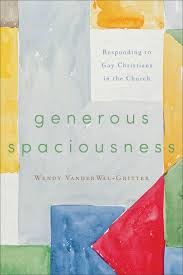 suggest — on this very topic of discussions about differences in theologies of inclusiveness in the church of GLTB believers — the book I have mentioned before as the best I can recommend for deeper, more faithful, more generous conversations, called Generous Spaciousness: Responding to Gay Christians in the Church by Wendy Vander Wal-Gritter (Brazos Press; $16.99.) You can see
suggest — on this very topic of discussions about differences in theologies of inclusiveness in the church of GLTB believers — the book I have mentioned before as the best I can recommend for deeper, more faithful, more generous conversations, called Generous Spaciousness: Responding to Gay Christians in the Church by Wendy Vander Wal-Gritter (Brazos Press; $16.99.) You can see 
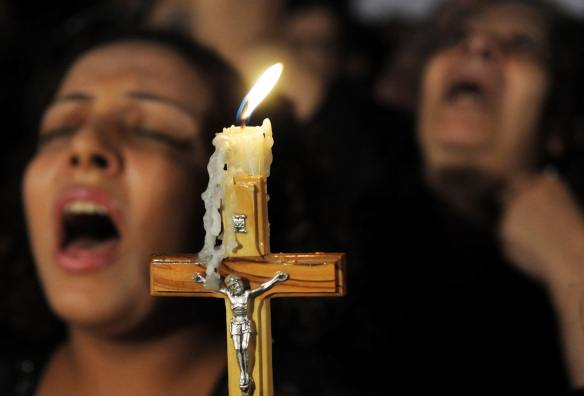
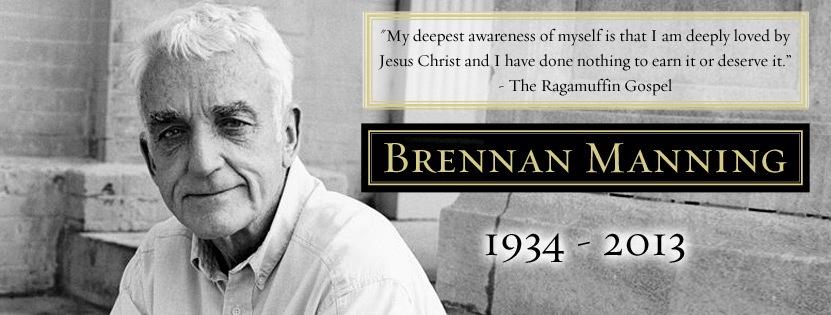
 realizing they were praying through the same book that same evening, watching as Henri hands Robert his plate of spaghetti, runs to his room to gather up the book in question, and read from it out loud. There is a story that is almost too amazing to believe – one about his friend Father Ed and a story of an old Irish priest – and there is a tender part with Robert telling about the suicide of his brother, and their relationship, strained and healed. The telling about an annual Nashville Christmas party is sublime, although some will be offended, I suppose. The evangelical guys who read the Mars Hill Review driving hours to Tennessee just to check in on him (and his initial misunderstanding the reason for their visit) is priceless.
realizing they were praying through the same book that same evening, watching as Henri hands Robert his plate of spaghetti, runs to his room to gather up the book in question, and read from it out loud. There is a story that is almost too amazing to believe – one about his friend Father Ed and a story of an old Irish priest – and there is a tender part with Robert telling about the suicide of his brother, and their relationship, strained and healed. The telling about an annual Nashville Christmas party is sublime, although some will be offended, I suppose. The evangelical guys who read the Mars Hill Review driving hours to Tennessee just to check in on him (and his initial misunderstanding the reason for their visit) is priceless.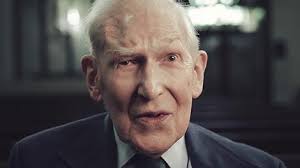
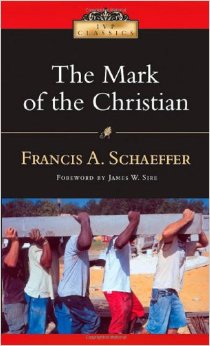 ecclesiastical moves continue to strain the worldwide communion of the Anglicans, and other denominations, his stance is a brave and principled one, and I am glad that Packer so inspired Armstrong to take up this current work. And I am glad they both frame the loving exhibition of friendships of church folks as Francis Schaeffer once did in his must-read little volume The Mark of the Christian (IVP: $6.00) in terms of the mission of the church. Our love for one another is, as Schaeffer reminds us, the “final apologetic.”
ecclesiastical moves continue to strain the worldwide communion of the Anglicans, and other denominations, his stance is a brave and principled one, and I am glad that Packer so inspired Armstrong to take up this current work. And I am glad they both frame the loving exhibition of friendships of church folks as Francis Schaeffer once did in his must-read little volume The Mark of the Christian (IVP: $6.00) in terms of the mission of the church. Our love for one another is, as Schaeffer reminds us, the “final apologetic.” 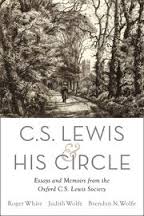
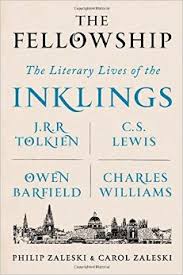
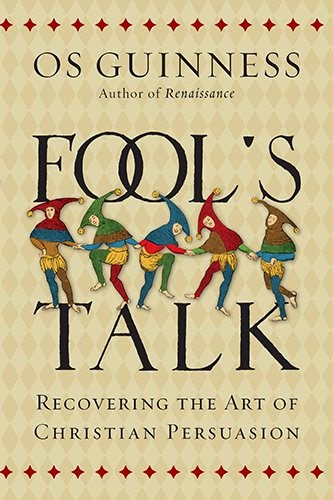
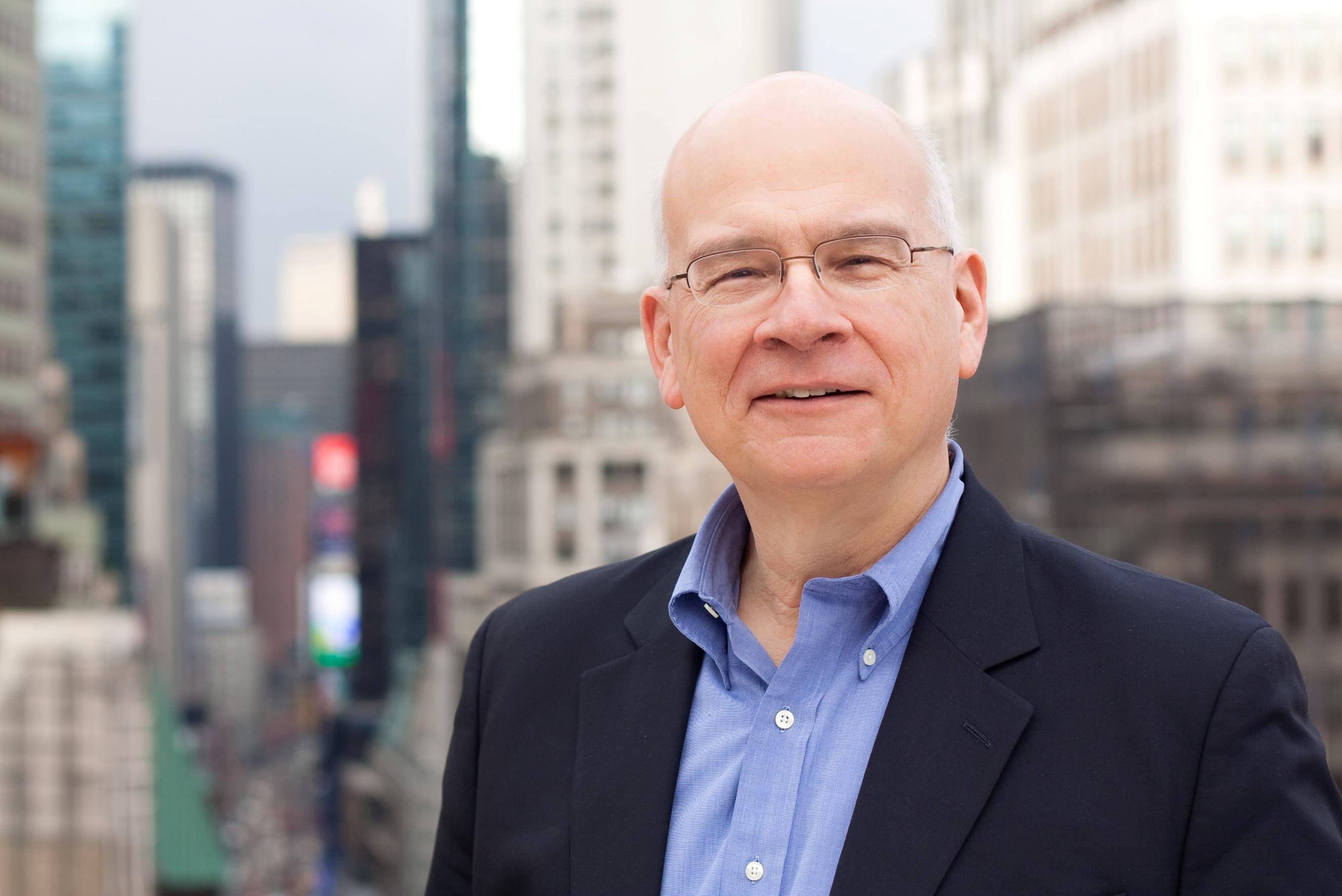
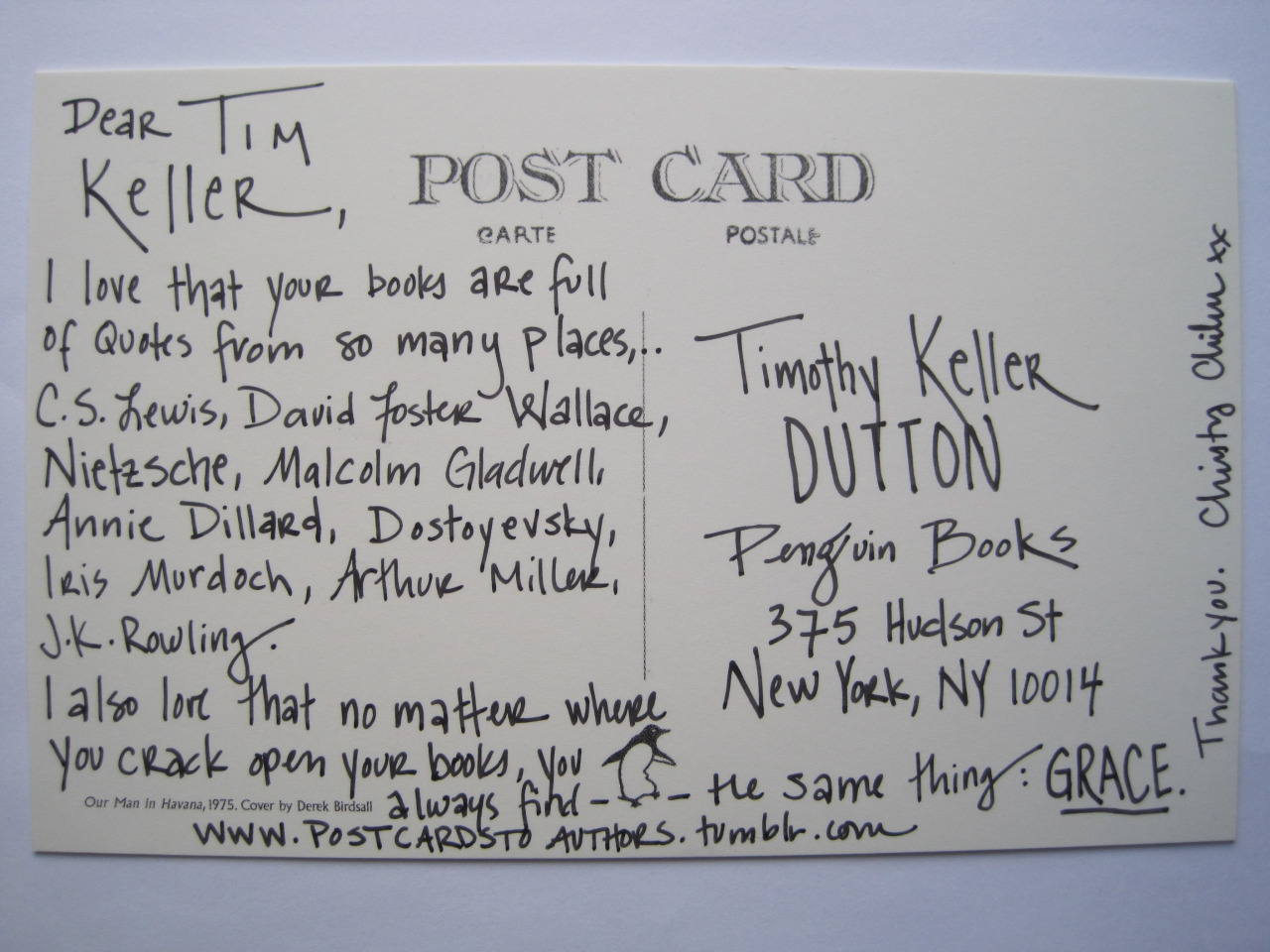 Road) and that he brings in to New York speakers such as N.T. Wright or co-authors books about the work world with business leaders such as Katherine Leary Alsdorf (Every Good Endeavor: Connecting Your Work to God’s Work) or has tackled the philosophical and pastoral questions about evil in Walking with God Through Pain and Suffering shows that he is a writer who is interested in real-world faith and whole-life discipleship. His big book about doing culturally-engaged church ministry is very good
Road) and that he brings in to New York speakers such as N.T. Wright or co-authors books about the work world with business leaders such as Katherine Leary Alsdorf (Every Good Endeavor: Connecting Your Work to God’s Work) or has tackled the philosophical and pastoral questions about evil in Walking with God Through Pain and Suffering shows that he is a writer who is interested in real-world faith and whole-life discipleship. His big book about doing culturally-engaged church ministry is very good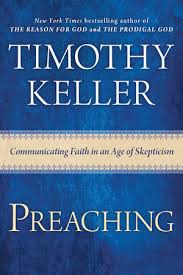 Timothy
Timothy 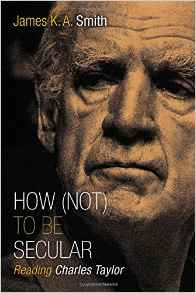
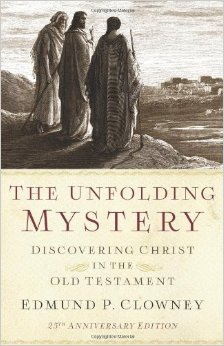 Clowney. (Dr. Clowney’s The Unfolding Mystery: Discovering Christ in the Old Testament (P&R; $12.99) is still a standard text in this movement.) Regardless of genre, Keller explains, one must see how each part of the Bible points toward Christ in particular ways. Also, through “every theme of the Bible” and in “every major image of the Bible.” On and on, this succinct chapter shows how this works and is itself worth the price of the book for anyone who reads the Bible, and certainly for anyone who teaches the Bible. There is some push back these days against this Christological hermeneutic, I realize, but, agree fully or not, this is sweet and fruitful stuff, I believe, and advice that most preachers, Sunday school teachers, youth leaders, camp counselors, campus ministers and Christian counselors of all sorts need to regularly recall. It is, after all, the method Jesus used to set on fire the hearts of those walking with him in the lovely passage about walking on the road to Emmaus.
Clowney. (Dr. Clowney’s The Unfolding Mystery: Discovering Christ in the Old Testament (P&R; $12.99) is still a standard text in this movement.) Regardless of genre, Keller explains, one must see how each part of the Bible points toward Christ in particular ways. Also, through “every theme of the Bible” and in “every major image of the Bible.” On and on, this succinct chapter shows how this works and is itself worth the price of the book for anyone who reads the Bible, and certainly for anyone who teaches the Bible. There is some push back these days against this Christological hermeneutic, I realize, but, agree fully or not, this is sweet and fruitful stuff, I believe, and advice that most preachers, Sunday school teachers, youth leaders, camp counselors, campus ministers and Christian counselors of all sorts need to regularly recall. It is, after all, the method Jesus used to set on fire the hearts of those walking with him in the lovely passage about walking on the road to Emmaus.
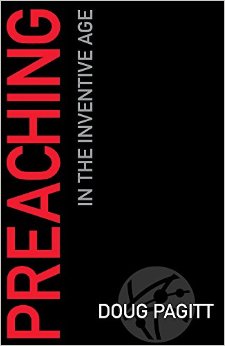 (I’ve just recently re-read Doug Pagitt’s creative book on dialogical “sermons” called Preaching in the Inventive Age which offers a very different take then Keller, but is quite stimulating, audacious as it is. Keller understandably is critical of it and its predecessors such as The Roundtable Pulpit and the work of Lucy Rose.)There are many different perspectives and angles and trends, curious things to ponder and clever new approaches to consider and I learn and am forced to think as I read from various viewpoints. I read old school stuff, lots of mainline/liberal textbooks, and try to dip in to dense tomes of communication theory, not to mention compilations of sermons, from Barbara Brown Taylor’s several collections, to, for instance, Brian Walsh’s powerful, must-read St. John Before Breakfast which are sermons (and liturgies) offered at the University of Toronto’s campus ministry morning Eucharistic service called “Wine Before Breakfast.”
(I’ve just recently re-read Doug Pagitt’s creative book on dialogical “sermons” called Preaching in the Inventive Age which offers a very different take then Keller, but is quite stimulating, audacious as it is. Keller understandably is critical of it and its predecessors such as The Roundtable Pulpit and the work of Lucy Rose.)There are many different perspectives and angles and trends, curious things to ponder and clever new approaches to consider and I learn and am forced to think as I read from various viewpoints. I read old school stuff, lots of mainline/liberal textbooks, and try to dip in to dense tomes of communication theory, not to mention compilations of sermons, from Barbara Brown Taylor’s several collections, to, for instance, Brian Walsh’s powerful, must-read St. John Before Breakfast which are sermons (and liturgies) offered at the University of Toronto’s campus ministry morning Eucharistic service called “Wine Before Breakfast.” 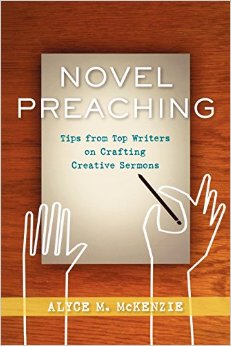
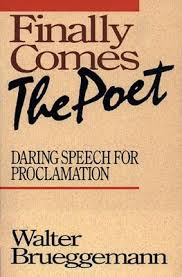 Of course, Walt Brueggemann has several collections of sermons, and several books about preaching — Finally Comes the Poet: Daring Speech for Proclamation may be his most popular — and they are well worth reading. We stock some interesting, practical ones such as Alyce McKenzie’s Novel Preaching: Tips from Top Writers on Crafting Creative Sermons. I really enjoy reading these kinds of resources — even though I most create talks and essays and the lessons for a small Sunday school class I sometimes teach.
Of course, Walt Brueggemann has several collections of sermons, and several books about preaching — Finally Comes the Poet: Daring Speech for Proclamation may be his most popular — and they are well worth reading. We stock some interesting, practical ones such as Alyce McKenzie’s Novel Preaching: Tips from Top Writers on Crafting Creative Sermons. I really enjoy reading these kinds of resources — even though I most create talks and essays and the lessons for a small Sunday school class I sometimes teach. 